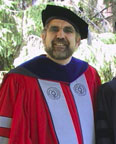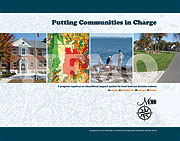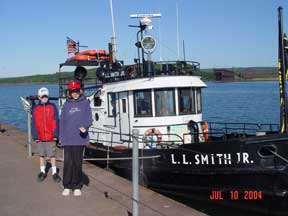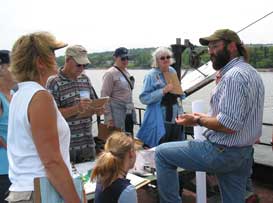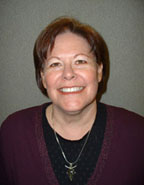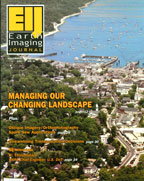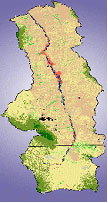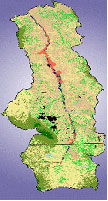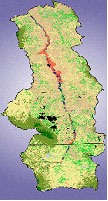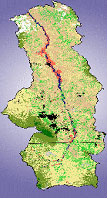Network News Archives
- BLOG
- 2011
- 2010
- 2009
- 2008
- 2007
- 2006
- 2005
- 2004
- 2003
- 2002
The National NEMO Network is blogging! We hope our blog will be useful in keeping you up-to-date on our latest research projects, training classes, workshops, webinars, publications, and anything else we feel like talking about. Below are some recent postings to our blog. Click an article you'd like to read or go directly to our blog page at nemonet.uconn.edu/blog.
08/11 - LID Fans
06/11 - Sustainable Sites Initiative Interactive Map
05/11 - Some Good Article Leeds
05/11 - LID Atlas is Still Growing
04/11 - Coastal Land Cover Atlas
08/11 - LID Fans
The University of New Hampshire Stormwater Center has just released their "Forging the Link" materials on the economic benefits of low impact development. As some of you may recall they gave us a preview at NEMO U7. The materials are very good and include a presentation, a manual, and a series of fact sheets covering the various benefits of LID, the economic benefits of LID, and LID as a climate change adaptation tool. The presentation includes some great case studies. See the press release below for more details.
You can check out the materials here http://www.unh.edu/unhsc/forgingthelink . They built these specifically for use by NEMO programs and other outreach educators, so don't be shy about putting them to good use.
Press Release
The UNH Stormwater Center, the Virginia Commonwealth University and the Antioch University New England are proud to release: Forging the Link: Linking the Economic Benefits of Low Impact Development and Community Decisions.
Forging the Link (FTL), is a comprehensive curriculum examining cost as one of the primary barriers to the implementation of low impact development (LID. The FTL curriculum demonstrates the:
1. ecological benefits of LID with respect to water quality, aquatic habitat and watershed health
2. economic benefits of using both traditional and innovative infrastructure to manage stormwater
3. capability of LID to be used as a climate change adaptation planning tool to minimize the stress on urban stormwater management infrastructure
The curriculum consists of a series of case studies from around the country presented in a resource manual, PowerPoint presentation, and delivery and facilitation Guides. It is available and designed for organizations that are tasked with educating on the topic of nonpoint source pollution and/or climate change for a municipal decision maker audience such as Nonpoint Education for Municipal Officials (NEMO), Coastal Training Programs (CTP), Sea Grant engagement experts, Cooperative Extension Agents, National Estuary Program (NEP) staffs, or other non-governmental organizations.
Forging the Link is a social-science and research based curriculum developed in partnership with end users (NEMO, CTP, Sea Grant, etc) and the intended audience (municipal decision makers). The FTL was funded by CICEET and NOAA and can be found : http://www.unh.edu/unhsc/forgingthelink
For more information contact Robert Roseen, PhD, Director, UNHSC, robert.roseen@unh.edu or Todd Janeski, Environmental Scientist, Virginia Commonwealth University, tvjaneski@vcu.edu.
06/11 - Sustainable Sites Initiative Interactive Map
I just discovered an interactive map put out by the Sustainable SItes Initiative (SITES) that highlights their pilot projects around the country. For those who aren't familiar with SITES, they are very symbiotic with NEMO - they promote sustainable land development and management practices and have come up with a nice site design rating system that is somewhat similar to LEEDs.
Anyway, the map is a good way to learn about some of the projects in your own backyard. Check it out here: http://www.sustainablesites.org/pilot/
05/11 - Some Good Article Leeds
- Our buddies at the UNH Stormwater Center have another article in the latest Stormwater Magazine. This time they look at the benefits of using LID/Green infrastructure in addition to grey infrastructure when managing Combined Sewer Overflows (CSOs). http://www.stormh2o.com/may-2011/economical-cso-management.aspx
- CWPs latest Watershed Science Bulletin focuses on integrating climate change science into stormwater management. 2 NEMO programs are featured:
- Arizona NEMO has a "vignette" on their efforts to help communities address climate change by providing watershed classifications and modeling to help determine which BMPs would be most effective in a given area.
- TX NEMO's John Jacob is also featured in the "Ask the Experts" section discussing his "No Regrets" approach to stormwater & community planning and climate change adaptiation.
CWP's publication is not online, but you can find out more about it here: http://www.awsps.org/watershed-science-bulletin.html
05/11 - LID Atlas is Still Growing
Atlas fans,
A couple quick updates on the National LID Atlas.
- The Atlas continues to grow, now highlighting 644 projects in 18 states (twice what we had this time last year). Hoping we can get to 4 figures and many more states.
- We just had an article published in the Marine Technology Society Journal on the Atlas. Check that out here: http://clear.uconn.edu/publications/research/articles.htm
- U.S. EPA Region 9 (AZ, CA, HI, NV, Pacific Islands, Tribal Nations) has added their funded projects.
- U.S. EPA Region 9 is also featuring the Atlas on their website. http://www.epa.gov/region09/water/lid/index.html
- U.S. EPA Region 4 (AL, FL, GA, KY, MS, NC, SC, TN, Tribes) is planning to add projects to the Atlas from their region soon.
04/11 - Coastal Land Cover Atlas
Our friends at the NOAA Coastal Services Center have released a really cool and useful tool that those of you in coastal states may be interested in checking out. It is called the C-CAP Land Cover Atlas and it provides robust land cover change data by county in coastal areas. You can view and print out county specific land cover change information, look at forest fragmentation data, changes in wetlands, etc. you can also create your own change statistics based on the types of land cover you are interested in. Very, very useful stuff.
Check it out at : http://www.csc.noaa.gov/digitalcoast/tools/lca/index.html
(click on "Get it Now" to launch the viewer)
08/10 - NEMO University (00)7
08/10 - National LID Atlas 2.0
08/10 - Nevada NEMO Creates an LID Plant Database
08/10 - Oregon NEMO's Rain Garden Guide
08/10 - Texas NEMO's Stormwater Wetland Publication
08/10 - North Carolina LID Guidebook & Training
08/10 - Partner News: Coastal Services Center Revamps Digital Coast
08/10 - National Maps on the Web Training
08/10 - Changes at Headquarters
08/10 - NEMO University (00)7
Maine. Portland, Maine is the site of the latest NEMO mission. While the location has changed, the goal of the mission is the same—extract vital intelligence that will be used back at home to protect water resources from poor land use decision making.
In most respects, this seventh iteration of NEMO University will be all you have come to expect from a NEMO conference and much more. There will be presentations galore from NEMO programs and partners across the country on topics ranging from low impact development to riparian buffers to nitrogen sinks. We will have a boat trip through the islands and lighthouses of gorgeous Casco Bay and a Family Lobster Bake.
U 007 will feature some very exciting plenary sessions. Leading the pack is a symposium on day two featuring Randall Arendt, the father of conservation planning. Mr. Arendt's work has "shaped a generation of planners, designers, and landscape architects." His session at NEMO U will focus on hybrid approaches to land use planning and site design using a number of techniques taken from conservation design, new urbanism, form-based zoning and low impact development.
Other plenary sessions will be equally engaging. One session will look at some very innovative approaches to conducting stormwater retrofits in very urbanized areas, the next major NEMO frontier. We have also put together a half day block of presentations on climate change, how it relates to traditional NEMO values, and ways folks are addressing it at the local level.
But wait, there's more. We have a quartet of field trips planned, including a tour of the University of New Hampshire's nationally renowned Stormwater Center, a habitat conservation tour of the Wells National Estuarine Research Reserve, a tour of an exciting urban retrofit project in South Portland, and an LID and Smart Growth Walking Tour of downtown Portland.
And, of course, there will once again be oodles of training options from using social science to beef up your NEMO programming to learning approaches to integrating the latest in LID research into your educational arsenal to creating interactive maps on the web with very little skill or effort.
Finally, in an effort to expand the opportunities for networking and information and resource sharing, we have expanded the audience beyond just educators who are part of the NEMO Network to anyone in the Sea Grant, USDA, NERRs or other outreach education networks who are working or interested in working with local land use officials on natural resource issues.
As luck would have it NEMO U 007 is the same week as another stellar conference being held in Portland, Maine - NOAA Sea Grant's Working Waterways and Waterfronts Conference. In addition the Sea Grant Sustainable Coastal Commmunity Development (SCCD) Network, many of whom are NEMO double agents, have decided to embed their national meeting within U 007. In short the opportunities for making intriguing connections with agents from other networks abounds! More than enough to sooth any seven year itch!
08/10 - National LID Atlas 2.0
The National NEMO Network has launched version 2 of the National Low Impact Development (LID) Atlas. Based on your feedback, we have made several adjustments to the Atlas that should make it an even more user-friendly resource for adding and locating low impact development projects around the country, including:
Adding projects made easy. No more waiting for a lonely grad student to wonder into your office looking for a volunteer project to get your projects added to the Atlas. Now, if you already have a database of LID projects, you can add them to the Atlas in one fell swoop. Just save/export your data as an excel file that matches the Atlas format. Contact the Hub for an excel template file.
Now works with IE. We fixed a glitch in the system that was confusing the popular yet antiquated Microsoft Internet Explorer, so the Atlas now should work fine in the current version of all major browsers.
Added search capabilities. We added the ability to search by project type, land use type and/or keyword to the embedded version of the Atlas (i.e. the version you can load on your very own website with just your state showing). For those who have already embedded a localized version of the Atlas to their website, you have already been upgraded to these new features.
08/10 - Nevada NEMO Creates an LID Plant Database
The NV NEMO program has added a searchable database of plants for use in low impact development projects. The list focuses on mostly native plants that are adapted to arid environments. You can filter the database based on a variety of categories (trees, grasses, etc.) and get a list of plants that link to images and characteristics. They also have a hardcopy of the printed list, if anyone is interested. It is a useful resource particularly for arid NEMO programs, but also a great approach for anyone to copy.
08/10 - Oregon NEMO's Rain Garden Guide
The OR NEMO team has developed a new 44 page publication, Oregon Rain Garden Guide: Landscaping for Clean Water and Healthy Streams. The guide is designed to help homeowners learn how to redesign home landscapes to help protect rivers and streams. While geared toward the Oregon climate and regulatory structure, its step-by-step approach teaches anyone how to determine where water flows across a homeowner's property; the best place to put a rain garden to manage water flow across impervious areas; and native perrenials that can be used.
08/10 - Texas NEMO's Stormwater Wetland Publication
The TX NEMO program has released an excellent publication focused on stormwater wetlands, entitled Stormwater Wetlands for the Texas Gulf Coast. Stormwater wetlands are ideally suited to retrofitting the stormwater detention and conveyance systems that are characteristic of the Texas coast. The publication explores the value of this approach and suggestions for implementing it.
TX NEMO has offered to share their files on the publication to others interested in adapting it for their state.
08/10 - North Carolina LID Guidebook & Training
The NC NEMO/WECO folks and their NC State University partners have put together a fantastic soup to nuts guide to LID. It covers everything from designing a practice to changing community plans and ordinances to integrating practices into a site design. It is a great resource and worth checking out. They have also launched an online LID training course to go along with the guidebook.
08/10 - Partner News: Coastal Services Center Revamps Digital Coast
Our comrades at the NOAA Coastal Services Center (CSC) have just revamped and relaunched their Digital Coast web resource. For those who have not visited Digital Coast, it is a valuable resource for confronting timely coastal issues, including land use, coastal conservation, hazards, marine spatial planning, and climate change. Content is provided by CSC and a variety of partners.
Some of the improvements to the site include better graphics, search functionality, and updated filters for narrowing down content within pages. Additional examples of specific enhancements include:
• A video tour of the website and how to use it,
• Coastal socio-economic data,
• A "recent updates" archive section so users can see what's been updated,
• An improved ability to receive updates, via a listserv sign-up, and
• An "approaches" section that provides case studies of how communities are using Digital Coast elements to address specific challenges.
08/10 - National Maps on the Web Training
The UConn Center for Land use Education and Research (CLEAR), institutional home of the NEMO Hub, has launched a new national geospatial training effort, Putting Maps and Geographic Data on the Web. The focus of the effort is on helping get researchers, educators, and outreach professionals started on sharing geospatial data over the web.
In just the last few years, the fusion of geospatial and web technologies have created unprecedented potential for the sharing of data, images, maps and information over the web, in a way that is easily accessible to all—including the non-GIS savvy. These technologies include open source Geographic Information System (GIS) methods and "mashup" technologies that allow the interplay of data with popular (and free!) web-mapping sites such as GoogleMaps and GoogleEarth.
CLEAR is providing training opportunities through a series of national and regional workshops, webinars, along with content and tutorials on the UConn CLEAR and eXtension websites.
The Putting Maps on the Web project is a collaborative effort of UConn CLEAR, the University of Rhode Island Coastal Institute, and the University of New Hampshire Geospatial Training Program. The project is funded by a four-year competitively-awarded grant from the USDA/NIFA National Integrated Water Quality Program.
08/10 - Changes at Headquarters
There have been big changes here at CT NEMO over the last year. Sir John Rozum, long-time CT NEMO Director and original National NEMO Network Coordinator left the mothership to pursue good coffee, foggy mornings, tasty pastries, and a great job in San Francisco with Natureserv and the NOAA Coastal Services Center. We miss him dearly, but are happy he landed in a friendly spot.
Jim Gibbons, the co-founder of NEMO and head of the land use planning program here at UConn decided to retire a little early. His knowledge of land use will be sorely missed not only here in Connecticut, but also throughout the Network.
In their place, we have hired two new hot shots to lead NEMO's water and land use education efforts in the state. Dr. Michael Dietz has returned to us after 4 years in Utah as the director of EcoHouse and an extension educator with Utah State University to take over the reins of CT NEMO and contribute to CT Sea Grant's sustainable coastal community development (SCCD) program. You may recall Mike already completed a tour of duty at NEMO as our main low impact development (LID) expert from 2005 to 2007.
On the land use side of the NEMO coin, we are equally fortunate to have hired Bruce Hyde, an AICP certified planner, to take over the CT land use planning program and Land Use Academy. In his varied 30 year land use planning career to date he has served as a town planner, a regional planner, senior project manager for a development company, and executive director of the New London Development Corporation. He knows land use and will be a tremendous resource not only here in Connecticut but to the Network at large.
09/09 - A National Low Impact Development Atlas Online
04/09 - CRI Online Tool Franchising Underway
04/09 - NEMO Co-Founder Retires!
04/09 - Chesapeake Bay Area Gives Birth to Twin NEMO Programs
04/09 - California's StormUlator Included in State Construction Permit Application
04/09 - Northland NEMO Helps Establish University Tree Ordinance
04/09 - Colorado's Sustainable Community Development Code
04/09 - NEMO U6 Full of Kicks
09/09 - A National Low Impact Development Atlas Online
The National NEMO Network has recently launched the Low Impact Development (LID) Atlas, a sophisticated website that is intended to show LID practices from around the country in a unique, interactive way. LID refers to a number of stormwater management practices, like grass swales, rain gardens, permeable pavements and green roofs that reduce runoff and help to protect water resources from the impacts of nonpoint source pollution. The new Atlas is a "mashup," using Google Maps in combination with local data to create a searchable map that covers the entire country. The Atlas was developed by a partnership of the Connecticut and California NEMO programs, and is coordinated by the National NEMO Network "Hub". The most advanced feature of the Atlas is that all 32 NEMO programs and their partners can enter data, photos and links for LID practices in their own state, and have them immediately appear on the national site. Thus, the hope is that within a year's time the national map will be festooned with the many-colored markers that mark the spot of an LID practice. "We're hoping for at least 500 entries by the end of the year," says Dave Dickson, NEMO Network coordinator. He adds that "this is an excellent example of the power of the Network to create unique educational products. Not many organizations could pull off something like this, and we did it with a minimal budget, just using the collective abilities of our network members."
04/09 - CRI Online Tool Franchising Underway
In January 2009, six NEMO programs gathered at the University of Connecticut's Avery Point campus for the Community Resource Inventory (CRI) Online Tool workshop. Funded by the Cooperative Institute for Coastal and Estuarine Environmental Technology (CICEET), the workshop demonstrated how the Connecticut CRI Online was built and helped other NEMO programs adapt the tool to their states. Once the other states develop their version of the CRI, the Hub plans to develop an online "cookbook" of the various recipes programs used to create such a resource.
NEMO Co-Founder Retires!
Jim Gibbons, co-founder of the original CT NEMO program and the National NEMO Network, has decided to retire. Jim helped most members of the NEMO Network get their programs going and is the Guru of natural resource based planning. His many contributions to the Network cannot be overstated and he will be sorely missed on several levels. While we wonder what the man who was made to give presentations will do now, we wish him the very best in his life of leisure.
Chesapeake Bay Area Gives Birth to Twin NEMO Programs
The Mid-Atlantic Region has officially joined the National NEMO Network with two new, yet closely linked, NEMO efforts—one focused on the Chesapeake Bay and one in the state of Virginia. Jonathan Doherty of the Chesapeake Bay Program in Maryland and Todd Janeski of the Department of Environmental Quality in Virginia lead the efforts. Both bring together a variety of partners, including Extension and Sea Grant.
California's StormUlator Included in State Construction Permit Application
The StormUlator tool, developed by California WALUP members, has been integrated into California's new draft NPDES Construction General Permit program. The StormUlator is a simple runoff calculator that estimates the amount runoff that can be reduced on a site through alternative stormwater management practices. The inclusion in California's draft construction permit guidelines is intended to help applicants ensure that runoff remains constant pre- and post- development.
Northland NEMO Helps Establish University Tree Ordinance
The Northland NEMO program worked with the University of Minnesota to develop a tree "ordinance" to guide tree preservation, protection, replacement and planting during construction activities. It is a great model for other Universities or communities and can be found in the "FREMO Resources" section of the National NEMO Network website.
Colorado's Sustainable Community Development Code
The Colorado NEMO program (AWARE Colorado) has developed a new publication on integrating LID/green infrastructure into local codes and ordinances. The publication is a piece of the Rocky Mountain Land Use Institute's "Sustainable Community Development Code," an effort to show communities how to make land use more "sustainable" in the face of community growth and global climate change. The code in general is a great resource and now with the addition of knowledge from CO NEMO, it's even better.
NEMO U6 Full of Kicks
The National NEMO Network held its sixth conference (NEMO U6) at beautiful Asilomar Beach in Pacific Grove, California on October 19-22, 2008, the first NEMO U held west of Charleston, South Carolina. It continued the NEMO tradition of an engaging, educational and enjoyable event and continued to be well worth fighting travel bans to make the trip. The conference agenda once again featured a mix of presentations, training sessions and networking events. For the first time, presentation abstracts were solicited from the Network and provided an opportunity for NEMO programs to show off their latest tools and resources. A broad range of exciting topics were covered from the StormUlator Tool (which helps to integrate low impact development into site design) to impervious cover based TMDLs (total maximum daily load) to habitat-based planning to clicker/ audience response system technology. Trainings included a session on using a variety of techniques and programs (most of which are free) to put maps and data on the web. There was also a condensed version of the Network's Forest Resource Education for Municipal Officials (FREMO) training and a plenary session on NEMOnomics, or integrating economics into NEMO education. Of course, it wouldn't be a NEMO U without great opportunities for networking among peers. We took full advantage of our location on Monterey Bay with an early morning kayaking trip, a whale-watching trip (including a sighting of an Orca pod), and a beachside bonfire and barbeque. The crown jewel of the networking events was a dessert reception at the world-renowned Monterey Bay Aquarium. In all, the conference fulfilled its goal of strengthening the bonds that hold our network together. And most importantly, one hundred percent of respondents to our post-conference evaluation indicated that they received knowledge or materials that will help them improve their NEMO program.
04/08 - NEMO Wins National Water Resources Award!
04/08 - Indiana NEMO Launches POWERful Tool
04/08 - CT NEMO Completes Stormwater Trifecta
04/08 - New York - A State so Nice, They Signed the Charter Twice
04/08 - Tech Training Troika Tested
04/08 - NEMO Wins National Water Resources Award!
The NEMO program, comprised of CT NEMO and the National NEMO Network, was awarded the 2008 Water Resources Team Award from the U.S. Department of Agriculture for "Outstanding Integrated Program" at the USDA Water Quality Conference in Reno, Nevada in February. The NEMO Team was recognized for establishing an "outstanding program that has had a significant impact on the protection of water resources in urbanizing areas across the country." While the lovely vase resides here in a place of honor, we view it as a collective award for the entire Network (maybe we should have it travel around the country a la the Stanley Cup). Many thanks to the USDA CSREES for the award and to our colleagues for nominating us.
04/08 - Indiana NEMO Launches POWERful Tool
The Indiana NEMO program (a.k.a Planning with POWER) has launched a new online tool called Local Community Decision Maker. This massive website is filled with maps and research on environmentally sensitive areas, land use change, economic development, potential sources of contamination and more. The tool seeks to provide local planning officials with all the resources necessary to adequately balance growth and natural resource protection. It is definitely worth a look and sure to inspire POWER-envy. Check it out at www.planningwithpower/dm.
04/08 - CT NEMO Completes Stormwater Trifecta
In March, CT NEMO unveiled a low impact development (LID) regulation website that allows users to search for and explore the entire text of LID-friendly planning and zoning regulations that their neighboring towns have adopted. This is the third of Connecticut's set of three integrated stormwater websites, collectively aimed at helping communities "get over the hump" in adopting LID and other innovative stormwater techniques. Much of the CT LID Inventory website (completed last year) is a portal to explore actual LID projects in other towns, this one helps them ensure their regulations permit or even encourage the use of LID practices. Go to nemo.uconn.edu/tools.htm.
04/08 - New York - A State so Nice, They Signed the Charter Twice
The ink is now dry on the latest Charter member of the National NEMO Network —Hudson River NEMO. The Hudson River Estuary Program, which is coordinated by the State's Department of Environmental Conservation, has decided to launch a NEMO program focused on the communities of the Hudson River Watershed. Barbara Kendall, a Cornell Extension employee with the Estuary program, will lead the effort. Of course, this is now the second NEMO program in New York with NY Sea Grant already coordinating a very successful program focused on Long Island. While this is great news for New Yorkers and the Network, we must admit that we are slightly bummed that we don't get to color in another state on the National Map. Oh, well, we take solace in the hope that the prehistoric-looking sturgeon (the "mascot" of the Hudson River Estuary) will soon join the list of cool NEMO program logos.
04/08 - Tech Training Troika Tested
In November of 2007, a sterling subset of NEMO Network members helped to beta-test a new three-day geospatial training workshop that focused on remotely sensed land cover information and how to use it. The training was developed as part of the NEMO Network's ongoing partnership with the NOAA Coastal Services Center (CSC), and also included partnerships with the National Association of Counties (NACo), the National Geospatial Technology Extension Network (NGTEN) and the Institute for Applied Geospatial Technology (IAGT). The training session was underwritten by a grant from NASA to the University of Connecticut Center for Land Use Education and Research (CLEAR), NEMO's parent organization. The workshop was comprised of three one-day modules that were designed to be combined in various ways, or stand alone as one-day sessions. The November "test trial" went through the Full Monty of all three modules: • Understanding and Accessing Remotely Sensed Information • Land Cover-Driven Landscape Analysis Models • Disseminating Your Data: Putting Maps and Data on the Web Five stalwarts each from the NEMO, NACo and NGTEN networks participated (photo), and helped to evaluate the modules and their potential. Feedback was solicited both from the official testers and from the various partner organizations who helped to develop the program. Overall feedback was very positive, and CSC and your faithful Hub are now wrestling with ways to fine-tune the workshops and make these modules available, perhaps working with NGTEN to provide trainers on a regional basis. We hope to broaden these conversations at NEMO U6. Also, a shorter form of the glowingly-reviewed "Putting Data and Maps on the Web," developed by CT NEMO's own Emily Wilson, will be offered at U6, so stay tuned. Thanks again to our sterling group of Network guinea pigs: Patrick Beggs of North Carolina, John Rozum of Connecticut, Monique Myers of California, Emma Melvin of Vermont and Frank "Bust a Move" Burris of Oregon. Anyone interested in the training sessions should contact Dave Dickson.
08/07 - A New Land/Forest Fragmentation Tool
08/07 - UConn & NEMO Release Jordan Cove CD
08/07 - New NEMOids in Minnesota Don’t Ya Know
08/07 - New England LID/BMP Database
08/07 - New York – A State so Nice, They Signed the Charter Twice
04/07 - FREMO! (Forest Resources Education for Municipal Officials)
04/07 - CT NEMO’s New CRI Website
04/07 - New NEMO Websites Launched in New Hampshire and Pennsylvania
04/07 - New and Transplanted NEMO Educators
04/07 - Cinco de NEMO: The Reviews are In!
08/07 - A New Land/Forest Fragmentation Tool
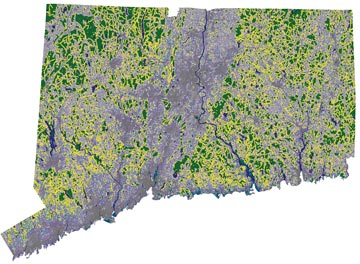 |
| Statewide map of CLEAR forest fragmentation analysis showing "core forest" areas in the green. The analysis is being made into a GIS tool by Placeways, Inc. for use in other states. |
In collaboration with the NEMO team, the geospatial wizards at UConn’s Center for Land Use Education and Research (CLEAR) and Placeways, Inc. (the CommunityViz people) have developed a new computer analysis tool that measure the impact of new roads, buildings and other development on the fragmentation of the natural landscape. As NEMO programs know very well, fragmentation—the breaking up of the natural, often forested, landscape into ever-smaller pieces—is widely recognized by researchers as having negative impacts on ecosystem health, wildlife and water quality.
While there are several methods to measure fragmentation, the new UConn-Placeways tool is unique in that it can be easily used within a geographic information system, or GIS, and applied to widely-available land cover data, derived from satellite-based information. The tool systematically analyzes each and every pixel of satellite-derived land cover data and compares what it sees to the pixels surrounding it. It then characterizes the state of the forest on a scale from “core forest” (forest completely surrounded by more forest) to “patch forest” (forest completely surrounded by development). The analysis is based on a technique developed by the U.S. Forest Service for analyzing forests on a global scale.
The landscape fragmentation tool will be valuable in demonstrating to local planning officials and staff the degree to which the natural landscape has been fragmented and helping them make land use decisions that avoid or minimize future fragmentation.
The tool is being made available in two forms. It has been incorporated into the Version 3.3 of CommunityViz in the form of a largely-automated “wizard” that makes it easy for users to apply. The core functionality is also available as an “ArcToolbox” geoprocessing tool suitable for use by more advanced users of ESRI’s ArcGIS software.
The ArcGIS version is available for free download from the CLEAR website at clear.uconn.edu or the Placeways website at www.placeways.com. A training in the use of the tool is also planned for the next NEMO U.
08/07 - UConn & NEMO Release Jordan Cove CD
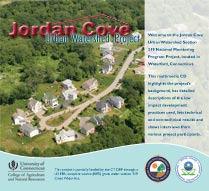 |
It’s finally here! UConn’s College of Agriculture and Natural Resources and CT NEMO have just completed a compendium CD of resources on the Jordan Cove Project. The project, which began in 1995, was designed to determine water quantity and quality benefits of using LID/BMP techniques in a residential subdivision.
The multimedia CD highlights the project’s background, has detailed descriptions of the low impact development processes used, lists technical and non-technical results and shows interviews from key players in the process. It is a great resource for anyone looking to demonstrate the effectiveness of Low Impact Development approaches. All hail to Mike Dietz (formally of CT NEMO) and our own Kara Bonsack for assembling and designing this excellent resource. To learn more or for a copy of the CD contact Jack Clausen at john.clausen@uconn.edu or call 860-486-0139.
08/07 - New NEMOids in Minnesota Don’t Ya Know
The Northland NEMO Program (Minnesota and Wisconsin) has added two new educators to their already impressive team. John Bilotta manages NEMO programming in the Twin Cities area of Minneapolis and St. Paul and assisting in updating NEMO based modules, building models to achieve effective stormwater education to decision makers, and building stormwater education programs for other urban areas in the State. Shahram “Shane” Missaghi will be developing new models of stormwater education and providing up-to-date recommendations for stormwater best management practices (BMPs) to urban audiences in the Twin Cities and other urban areas of the state. Welcome to the Network John & Shane!
08/07 - New England LID/BMP Database
In hopes of making innovative stormwater practices more widespread, New England NEMO programs and the UNH Stormwater Center have unveiled an online database of LID/BMP installations in the New England Region. The site provides details and contact information on pervious pavers, green roofs, rain gardens, vegetated swales, and other stormwater treatment practices that have been installed throughout the region. Users of the site can search by practice or by state and can submit sites for inclusion in the database. It is modeled after CT NEMO’s LID Inventory (clear.uconn.edu/tools/lid/index.php) and New England NEMOids worked with the Stormwater Center to help populate it.
Check it out here: www.erg.unh.edu/lid/index.asp.
08/07 - New York – A State so Nice, They Signed the Charter Twice
The ink is almost dry on the latest Charter member of the National NEMO Network, Hudson River NEMO. The Hudson River Estuary Program, which is coordinated by the State’s Departmnet of Environmental Conservation, has decided to launch a NEMO program focused on the communities of the Hudson River Watershed. Barbara Kendall, a Cornell Extension Employee with the Estuary program, will lead the effort.
Of course, this is now the second NEMO program in New York with NY Sea Grant already coordinating a very successful program focused on Long Island. While this is great news for New Yorkers and the Network, we must admit that we are slightly bummed that we don’t get to color in another state on the National Map.
04/07 - FREMO! (Forest Resources Education for Municipal Officials)
As many of you know, the Network Hub is partnering with the USDA CSREES Forestry Program and the U.S. Forest Service to integrate forest cover and forest resource issues into NEMO educational programs. Similar to the Open Space Planning project that only grizzled NEMO veterans are likely to remember, FREMO will lead to the development of new educational materials and wiz-bang tools for adaptation and adoption by interested Network programs.
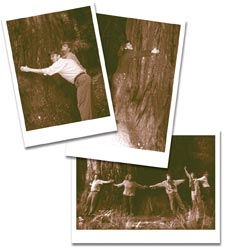 |
| Tree huggers of the Network, Unite! |
From slowing runoff, to filtering pollutants and preventing erosion, the nation’s forests protect water quality. In addition, forests provide habitat for fish and wildlife, recreational opportunities, and economic resources. However, the ability of the nation’s forests to provide these services is threatened by the conversion of forest lands to housing and other development, the fragmentation of forest systems, and subdivision into small tracts managed by numerous individual owners.
By and large, most forestry education efforts throughout the country have focused on individual landowners. However, it has become increasingly apparent that there is a need to also educate local land use decision makers about the importance of the forest resource in land use planning. Since educating local officials is what NEMO is all about, the FREMO effort seems a logical fit.
After announcing the initiative at Cinco de NEMO, the Hub conducted a survey of the Network to get a sense of the current levels of knowledge, interest, and integration of forest resource issues into NEMO programming. In general, the responses indicate a strong interest in the effort. And, while most NEMOids feel they have a decent understanding of forest resource and forest cover issues, few feel their knowledge is sufficient to integrate these issues into their educational arsenal. The lack of educational models/methods was cited as the biggest obstacle to integrating forest issues into NEMO.
Whether as a result of pure luck, savvy survey design or fleeting omnipotence, the survey results fit perfectly with our plan for year one of the project. In collaboration with forestry experts from around the Network and elsewhere, we are developing new educational materials that integrate forests into NEMO’s mantra of natural resource- based planning. In September, we will hold a FREMO workshop for Network members on basic forestry concepts as they relate to land use planning, and the use of the new educational materials.
Should we be able to induce our wonderful federal partners to continue funding this effort in future years, we plan to help catalyze new forested NEMO efforts through mini-grants and collaborations with Extension foresters. In addition, to help enhance our message we will seek to train NEMO programs in the use of several emerging geospatial tools that can help to both analyze and visualize tree cover and forest fragmentation.
04/07 - CT NEMO’s New CRI Website
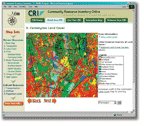 |
| The new CT NEMO CRI website includes a Build Your CRI page. The land cover map for the town of Farmington, CT is shown above. |
The CT NEMO Team released the Online Community Resource Inventory (CRI) this winter, a new web-based tool that allows users to take the first step in integrating natural resources into land use planning. The CRI provides access to a series of key natural resource maps, including water resources, land cover, protected open space and wetland soils and farmland soils, in additional to cultural resources such as roads and utilities.
CT NEMO and the Hub are now collaborating with the NEMO and Geospatial Technology Programs in Rhode Island to further improve the tool, as well as franchise it in the Ocean State. In doing so, we hope to create a cookbook of sorts to help other interested members of the Network develop similar sites of their own, with Minnesota and South Carolina already agreeing to be the first guinea pigs.
04/07 - New NEMO Websites Launched in New Hampshire and Pennsylvania
The NEMO programs in New Hampshire and Pennsylvania have both launched new websites for their programs. The NH NEMO effort, the Natural Resource Outreach Coalition (NROC), provides overall program information, as well as detailed examples of what different communities have done.
The NROC site can be found at: http://extension.unh.edu/CommDev/NROC/CANROC.cfm.
The PA Lake Erie NEMO program website also features program information and project highlights, as well as geospatial data for the major watersheds in their target area.
The PA Lake Erie site can be found at: http://seagrant.psu.edu/nemo/.
04/07 - New and Transplanted NEMO Educators
The NY and CT NEMO programs have both added new staff to their teams, while CA plucked a high-profile free agent from the OH NEMO program. In NY, Eileen Keenan added Jeanne Brown to the NY NEMO team. Jeanne is a veteran of the Peace Corps with a background in Marine Policy and Biology. Likewise the CT program bolstered its biological prowess in hiring Dr. Juliana Barrett, an ecologist and evolutionary biologist. Juliana will help CT NEMO expand its educational assistance in coastal areas. And finally the California Center for Water & Land Use managed to lure Dr. Timothy Lawrence away from Ohio NEMO to help lead the CA NEMO program. Details of the deal were not released, but it has been widely speculated that Dr. Lawrence’s interest in frolicking with the playful sea otter played a prominent role in the negotiations. Ohio’s former bench coach, Jon Witter has taken over the NEMO reins back in Ohio.
04/07 - Cinco de NEMO: The Reviews are In!
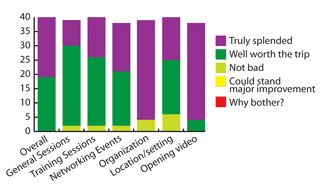 |
From the standpoint of those of us here at the Network Hub, Cinco de NEMO was extremely successful. Folks seemed to enjoy themselves, the formal sessions were lively, the informal sessions were livelier, there was a lot of networking going on, and no one got hurt. More important, based on the responses to our online evaluation form, you all thought the conference was helpful, which of course is the whole point. And most important, the Opening Video and Conference Organization scored the highest, which we take as sign that you haven’t gotten (too) tired of the Hub yet.
Please go to the secure (For Members) section of the National Network website for more results.
09/06 - Network GIS & Remote
Sensing Training
09/06 - Oregon Joins the Network, Again
09/06 - USDA CSREES Highlights the Network
09/06 - COors NEMO?
09/06 - NROC On!
09/06 - New Directions
08/06 - CT NEMO Receives Outstanding Achievement
Award
03/06
- Technically Speaking
03/06 - The Taco the Town, Cinco de NEMO
03/06
- NROC Rocks!
03/06
- Delaware
Natural Resource Based Planning Guide & Training
03/06
- National Journal Highlights RI NEMO & VT NEMO Partner
03/06
- Florida Joins the Network
09/06 - Network GIS & Remote Sensing Training
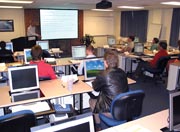 |
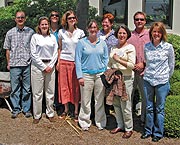 |
| Network participants in Charleston, SC. |
In April, a gaggle of NEMOids traveled to the NOAA Coastal Services Center (CSC) in Charleston, South Carolina for an encounter of the geospatial kind. The training grew out of the training needs survey Network members filled out last fall and was the first step in the Hub’s effort to work with partners like the Center to expand training opportunities for the Network.
The four day training provided an introduction to the ArcGIS software program and to the use of remote sensing data. The idea was to provide an opportunity for geospatial novices/beginners in the Network to get a basic knowledge of geospatial tools and how they can be used to enhance NEMO education. Many, many thanks to the CSC for putting on the training. Several of the participants have already taken what they learned at the training and applied it to their programs.
The NEMO Hub will seek to build upon this first step down the path toward a “Network Training Academy” at Cinco de NEMO (NEMO University 5). In addition to more advanced geospatial training and topical training, the conference will provide an opportunity to solicit ideas for future training opportunities.
09/06 - Oregon Joins the Network, Again
It took three workshops in three different communities and 30 hours in a University van, but the Hub is delighted to report that Oregon has rejoined the Network as a Charter member. The new, statewide effort will be lead by Derek Godwin, Frank Burris and Sam Chan of Oregon State University Extension and Sea Grant, and has been named “Growing Oregon.” It seems only fitting that the state that has long been the leader in coordinated community planning be part of the Network. We welcome them and their experience to NEMOdom.
09/06 - USDA CSREES Highlights the Network
One of the main funders of the NEMO Network, the USDA’s CSREES National Integrated Water Quality Program, has chosen to honor our little Network as one of their “Outstanding Projects.” The local actions being catalyzed by NEMO education will be highlighted in a prominent display at the USDA headquarters Building, as well as the CSREES Administrators Office, on the National Mall in Washington DC. We congratulate NEMO coordinators everywhere for this honor and thank our funders for thinking of us.
09/06 - COors NEMO?
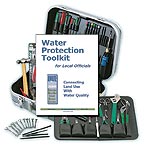 |
AWARE Colorado has received a grant from the Coors Brewing Company to distribute their fantastic Watershed Protection Toolkit for Local Officials to every county and municipality in the state. Certainly a big step forward for the program’s effort to reach every corner of Colorado. You can download your very own copy of the toolkit on their website at www.awarecolorado.org.
09/06 - NROC On!
The New Hampshire NEMO program (NROC - Natural Resource Outreach Coalition), has just released a new publication, Setting Goals, Redefining Boundries, highlighting what many of the towns they have worked with have accomplished. The publication is an impressive array of changes coastal communities have made, from building the capacity of local land use decision makers to changes to plans, policies and regulations. The document is available on the Member Publications section of the Network website.
09/06 - New Directions
As NEMO continues to evolve both in each state and as a Network, it’s only natural that we find ourselves going in new directions. And, although Your Friendly Neighborhood Hub has its share of “Y” chromosomes—which everyone knows makes it impossible to ask for directions of any kind—this has not deterred us from exploring several new ways of enhancing and supporting the Network. Our progress on these fronts will be on display at Cinco de NEMO (NEMO University 5), where there will be an unimaginatively but aptly named “New Directions” panel. We’re excited about the panel, for the simple reason that never before have we been able to put together three such promising pieces of good news. A few words on each:
The first item will be the most familiar, as it involves our old friend the NOAA Coastal Services Center (CSC). Since U4ia, the Hub and CSC have been discussing strengthening our long-term partnership. In the near future, this will take the form of increased opportunities for geospatial technology training for NEMO Network members. The results of our web survey on your geospatial technology use and needs have helped to guide us to this point. We hope that the inclusion of CSC’s new regional staff in our regional discussions at Cinco will help us further refine our plans.
The second item is also related to technical tools. CICEET, the Cooperative Institute for Coastal and Estuarine Environmental Technology, is a partnership between NOAA and the University of New Hampshire that supports the development of innovative technologies for understanding, protecting and restoring coastal resources. CICEET has been consulting with the NEMO Hub as part of their recent effort to revise the focus of their annual call for proposals. Suffice it to say that land use and land use decision makers feature prominently in this new focus—potentially great news for NEMO programs.
The last piece of good news is perhaps the
newest of new directions. As most know, the Network has benefited from
critical support from the USDA/CSREES Water Quality Program, which supports
the Hub as a “National
Facilitation” project. Recently their brethren in the CSREES Forestry
Program have also become interested in the NEMO Network. Concerned about
issues like retaining forest cover and minimizing forest fragmentation,
the Forestry Program has come to the conclusion that traditional forestry
outreach to landowners needs to be supplemented by education of (drum
roll please …) local land use officials. Can TreeMO be far behind?
Stay tuned!
Now, if we could only bring ourselves to ask for directions ….
08/06 - CT NEMO Receives Outstanding Achievement Award
The CT NEMO Team has been awarded the 2006 Outstanding Achievement Award by the Renewable Natural Resources Foundation (RNRF) for their Putting Communities in Charge publication. As you probably know, this is the CT NEMO program’s first official compilation of some of the local actions that have been catalyzed by CT NEMO. The Report can be ordered online on the NEMO website's Publications section. The official press release is also attached for those who want to learn more.
03/06 - Technically Speaking
Pssst…hey you…yeah, you over there, in the NEMO hat—you need training? Well, you came to the right place. You name it, we got it. We got your RS, your LID, your GIS, your ISAT, your CommunityViz… whatever you need.
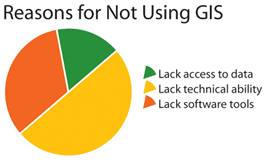 |
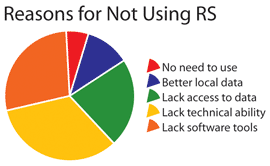 |
Last Fall, the Hub asked NEMO program coordinators to complete a Geospatial Expertise & Training Needs Survey to gauge use, proficiency and interest in a variety of geospatial tools, as well as interest in topical training. While practically all programs see a need for using geospatial tools, lack of proper software and technical knowledge were cited as the biggest barriers to their use (See graphs. Members can view complete summary results here, scroll Bulletin Board items.) align="left">To help all Network programs take full advantage of the educational potential of geospatial technology, the NEMO Hub, in partnership with the NOAA Coastal Services Center (CSC), is seeking to develop technical training opportunities for the Network. Our first step is to offer basic GIS and Remote Sensing Training to NEMOids this Spring (April 2-6) at the CSC in Charleston, SC. Educators from seven NEMO programs and two non-techie Hub staff (namely, Kara and Dave) will participate in the training. The hope is that the training will allow us to take advantage of more advanced training in the near future. The next step is to beef-up training offerings at the next NEMO U, Cinco de NEMO, October 16-19 in Middletown, Connecticut. Cinco de NEMO will include 2 full days of training in two tracks, a geospatial track and a topical track. The geospatial track will include training in the use of CommunityViz planning software, the NSPECT nonpoint source modeling tool, and, of course, our own ISAT, which estimates impervious coverage. The topical track will include a full day of Low Impact Development (LID) training and a day on the use of land cover indicators (impervious cover, forest cover, riparian buffers) to assess watershed health. We have enlisted the help of our friends from the NOAA Coastal Services Center, the Center for Watershed Protection, Placeways (the maker of CommunityVis) and a small fleet of LID experts to lead these training sessions. We hope that Cinco de NEMO will also provide an opportunity to further discuss training needs within the Network and develop a plan for a full-fledged NEMO Training Academy with trainings in “off years” as a counterpoint for NEMO Universities.
03/06 - The Taco the Town, Cinco de NEMO
Doesn’t it seem like just yesterday we were subjecting you to all kinds of U4ic punnery? Well hold on to your sombreros, because NEMO U5, a.k.a Cinco de NEMO, is only a few months away. For this 5th installment of the National NEMO Network conference, we are returning to foliage filled Connecticut in the fall—October 16-19, 2006 in Middletown. The Network Hub has been busy working with the Conference Advisory Committee (the Cinco NEMigos) to craft an agenda that meets the standards for networking, ideas and camaraderie you have come to expect from a NEMO U, with an extra dose or two of training thrown in. In addition to the usual network updates, regional meetings, poster reception, presentations and a boat trip, we are including two full days of training along two separate tracks, one geospatial and one topical, to provide more bang for your scarce travel buck. Why Middletown? Well, with a theme like Cinco de NEMO, we figured what could be more apropos than a small New England town? Plus, Middletown is a delightful, walkable town on the banks of the Connecticut River, one of the so-called “Last Great Places in America”. Chock full of restaurants with cuisine from all over the world, including two restaurants where you can order a chimichanga, Middletown is sure to surprise. Honestly, you never sausage a place.
Members, be sure to visit the Cinco de NEMO website for all the details.
03/06 - NROC Rocks!
The New Hampshire NEMO program, NROC (Natural Resources Outreach Coalition) has received a glowing assessment of its effectiveness in helping the state’s coastal communities address conservation and growth. The assessment was conducted independently by the Institute for New Hampshire Studies at Plymouth State University and consisted of a review of NROC materials and presentations, interviews with the program’s partners and a community survey. The Institute concluded that the program has energized local officials to address conservation and growth, enabled them to more effectively address land use and water quality issues, and is the most cost effective option for using available resources to effect land use.
Rock on, NROC!
03/06 - Delaware Natural Resource Based Planning Guide & Training
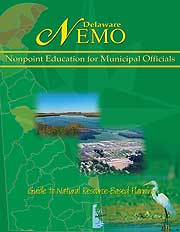 |
Delaware NEMO is pleased to announce the availability of their new publication Delaware NEMO: Guide to Natural Resource Based Planning. The resource guide provides an overview of natural resource management principles and practices to help guide local planning commissions and councils as they weigh the decisions of what to preserve and where to develop. It will be distributed throughout the state and is being used as the basis for a half day course on Natural Resource Based Planning as part of the University of Delaware’s Local Government Leadership program. The Guide draws from the expertise of DE NEMO’s advisory committee members, as well as natural resource based planning materials from the CT and Northland NEMO programs.
While hard copies are reserved for Delaware officials, Joe Farrell, Delaware NEMO Coordinator, has offered to send CD versions to all NEMO partners who want one. Just send him an email with your mailing address at jfarrell@udel.edu. The manual will also be available in a web version on DE NEMO’s new website, nemo.udel.edu, which will be up and running in April.
Delaware NEMO is also sponsoring an ongoing Conservation Design Roundtable to bring together local government officials, developers and design consultants, and state agencies to encourage the use of low impact development (LID) approaches and to bridge institutional barriers. The next Roundtable workshop in March will feature NEMO partner Lynn Richards in EPA’s Office of Policy, Economics and Innovation.
03/06 - National Journal Highlights RI NEMO & VT NEMO Partner
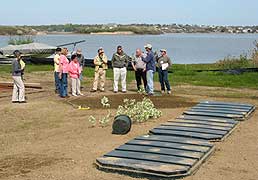 |
| Participants in a NEMO U3 conference field tour get a first hand look at a demonstration recirculating peat filter (treatment unit in foreground) designed to reduce nitrogen and pathogens entering Green Hill Pond, in Charlestown, RI. George Loomis, Director of URI's New England Onsite Wastewater Training Center, describes basic operation and maintenance. |
Small Flows Quarterly, an EPA-funded publication by West Virginia University that is focused on small communities and their wastewater issues, ran a front page article highlighting the RI NEMO program in their Winter 2006 issue. The article, entitled Wastewater Planning is an Integral Part of Smart Growth, features RI NEMO Director Lorraine Joubert, and her programs and publications on wastewater management and planning. It also features Juli Beth Hinds, Director of Planning and Zoning for South Burlington, Vermont. Juli is a key advisor to the new VT NEMO program.
The article makes a strong case for wastewater system planning as an overall community planning tool. To quote Lorraine: “…a wastewater treatment system is a tool for the community to use to achieve their land-use goals, whether that means controlling sprawl in rural areas or whether it is redeveloping or revitalizing an existing historical downtown area or growth center.”
The Article can be found on the web at: www.nesc.wvu.edu/nsfc/nsfc_sfq.htm. Congrats to Lorraine and RI NEMO.
03/06 - Florida Joins the Network
Florida Sea Grant, in collaboration with the Apalachicola National Estuarine Research Reserve (NERR), has launched a NEMO program and signed on as a Charter member of the NEMO Network. The program is led by Brian Cameron (Sea Grant) and Rosalyn Kilcollins (the Reserve) and will focus its efforts, at least initially, on the rapidly growing areas of the panhandle and Northern Florida. After officially joining the Network in December, the program has already demonstrated it is no Mickey Mouse operation. They are already seeing impacts! After a few basic NEMO presentations, the town of Carrabelle strengthened its stormwater management plan. For those who keep NEMO Bingo cards in their desk drawer, the Sunshine State NEMO (a.k.a. North Florida NEMO) makes 32 programs in 31 states that have joined the Network.
10/05
- 2005 National NEMO Network Progress Report Charting a Course
for Better Land Use
10/05
- After the U4ia Subsides
10/05 -
Northland NEMO Wins Merit in Planning Award
10/05 -
Nevada and Connecticut NEMO Programs Honored with Outstanding
Educational Materials Awards
10/05 -
NEMO: The New TV Show
10/05 -
Kudos Tim
10/05 -
Welcome New NEMOids!
08/05
- NEMO Team Institutes New “Hawaiian Shirt Friday” Policy
04/05
- The National NEMO Network’s Fourth NEMO University
Conference is a Success
04/05
- AZ NEMO's Kristine Uhlman is named to the State's Water
Protection Fund Commission
03/05
- New York Sea Grant Adds Two New Team Members
02/05
- AWARE Colorado's Toolkit for Local Officials is Released
02/05
- The History of NEMO University
02/05
- New Network Members
02/05
- CT NEMO’s New Publication, Putting Communities in Charge
02/05
- Northland
NEMO's "View from the Lake" Program is a Success
02/05
- Nevada NEMO Coordinator, Sue Donaldson, Honored
01/05
- NEMO Featured in the Earth Imaging Journal
10/05 2005 National NEMO Network Progress Report Charting a Course for Better Land Use
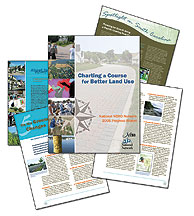 This
summer the National NEMO Network released its second progress report, Charting a Course for Better Land Use,—kind
of the Network’s Greatest Hits Volume 2. The Report provides
a sampling of local actions that have been catalyzed by NEMO programs.
This
summer the National NEMO Network released its second progress report, Charting a Course for Better Land Use,—kind
of the Network’s Greatest Hits Volume 2. The Report provides
a sampling of local actions that have been catalyzed by NEMO programs.
The first Network progress report, issued in 2003, focused on how the various NEMO programs developed, how they were structured and what they had begun to accomplish. Now that the Network and many of its programs have been around for a few years, those accomplishments have grown into what we feel is a truly impressive body of work. Therefore, this report focuses on “impacts”—the local actions that have been catalyzed, initiated, supported by or in some other way set into motion by NEMO programs.
In compiling this report, we at the Network “Hub” were delighted and impressed by all that our colleagues around the country have accomplished and the wide range of local actions that they have helped set into motion. From changes to community plans to improved land use regulations to on the ground changes, it is clear that education is working in communities across the country.
The report has been distributed far and wide within the Extension and Sea Grant networks, to our many federal and state partners, to a few folks in Congress, and all members of the Network Coordinator’s extended family over age 3. Nevertheless, there are still plenty available in the catacombs beneath the Hub’s Humble Haddam home for anyone interested. Contact Kara Bonsack at 860-345-5227 or kara.bonsack@uconn.edu to request copies of the report.
10/05 After the U4ia Subsides
Well, it took a while, but the U4ia has subsided. This fourth iteration of the Network’s national conference was certainly the largest, with participation from 53 existing and potential NEMOids and an equal number of NEMO partners from federal agencies and national organizations. In its wake, U4ia has left a pleasant hang-over in the form of new ideas and energy that is guiding the Network forward.
First, U4ia has helped regional networking take hold. The Great Lakes/ Midwest folks have been meeting regularly via conference call and are considering a face-to-face confab later this year. The Northeast NEMO programs are participating in a regional Stormwater LID Training Workshop in early November. In the South, NEMO programs are meeting at the USDA Regional Water Quality Conference to discuss bringing the NEMO message to the rural south.
Second, we are in the process of revising the National NEMO Network website to better highlight the great things NEMO programs are doing, while also bulking up and streamlining (if that is possible) the member resources section.
Third, since U4, we have been in discussions with the NOAA Coastal Services Center and Center for Watershed Protection to find new ways to bring their resources to the Network. One idea is to institute a NEMO Training Academy as a complement/counterpoint to the more networking-focused NEMO U conference and help infuse the Network with new tools, ideas, skills and resources. Thanks to all the Coordinators who filled out our handy-dandy web survey on training needs. We are currently in the process of evaluating your feedback and hope to get started on some form of Network-wide training by the spring.
Finally, we have already begun casting our sights on Cinco de NEMO (a.k.a. NEMO U5), coming to a location near you in the fall of 2006. Look for a “Save the Date” announcement soon!
10/05 Northland NEMO Wins Merit in Planning Award
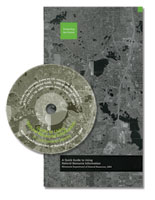 Northland
NEMO’s multimedia Guide to Using Natural Resource
Information in Local Decision Making has been honored with a Merit
in Planning Award from the Minnesota Chapter of the American
Society of Landscape Architects. In addition, the regional planning
agency for the seven county Minneapolis/St. Paul area is using
the guide to help communities prepare a required update of their
comprehensive plans. The idea/inspiration for the guide came out
of the NEMO Network’s
2002 Open Space Planning Boot Camp.
Northland
NEMO’s multimedia Guide to Using Natural Resource
Information in Local Decision Making has been honored with a Merit
in Planning Award from the Minnesota Chapter of the American
Society of Landscape Architects. In addition, the regional planning
agency for the seven county Minneapolis/St. Paul area is using
the guide to help communities prepare a required update of their
comprehensive plans. The idea/inspiration for the guide came out
of the NEMO Network’s
2002 Open Space Planning Boot Camp.
View the Guide online at www.dnr.state.mn.us/nrig/index.html.
10/05 Nevada and Connecticut NEMO Programs Honored with Outstanding Educational Materials Awards
A selection from the NV NEMO fact sheet series.
The Nevada and Connecticut NEMO programs have been honored with “Outstanding Educational Materials Awards” from the Association of Natural Resource Extension Professionals (ANREP). Susan Donaldson with NV NEMO won a Silver award for her adaptation of the NEMO Fact Sheet series in the “Long Publication” category (she also copped a Gold award for her Truckee Meadows Weed Coordinating Group Public Outreach Campaign and a Silver award for her Are Invasive Weeds Ruining Your Neighborhood? publication). The CT NEMO Team received a Bronze award for the Connecticut’s Changing Landscape (CCL) website in, appropriately enough, the “Web Page” category.
View Susan’s NEMO fact sheets and visit the CCL website.
10/05 NEMO: The New TV Show
Minnesota’s Lakes at Risk is a brand new television program about the impacts of development on lakes and the importance of long term investments to protect our valuable lake resources. The program talks about how increasing development, on the shoreline and in the watershed, impacts habitat and water quality. It goes on to discuss what citizens and local officials can do to restore and protect lakes.
The program (debuting October 30 on PBS’s Minnesota Channel in the Twin Cities) is based on Northland NEMO’s Linking Land Use to Lake Quality presentation.
10/05 Kudos Tim
After years of hard work and stunning academic achievement, Ohio NEMO’s Tim Lawrence has earned his PhD from The Ohio State University. The ceremony was even broadcast live over the internet, certainly due to his national reputation and large following Dr. Lawrence has received as a result of his illustrious work as coordinator of Ohio NEMO. Seriously, Tim, congratulations!
10/05 Welcome New NEMOids!
Several new NEMO coordinators and staff have joined the Network over the past few months. Many of you met >Steven Mikulencak and Christy Witters of NY NEMO at NEMO U4. While Christy has since moved to Vermont, Steven continues to work with Eileen Keenan to expand NY NEMO’s work on Long Island.
Michael Deitz has joined the CT NEMO team in the unofficial position of Dr. Stormwater (officially he is an Extension Educator specializing in low impact development (LID) stormwater practices). Mike earned all of his degrees at UConn, including his recently completed PhD from the Natural Resources Management and Engineering Department.
The new VT NEMO Program, which is coordinated by the Lake Champlain Sea Grant Program, recently hired Emma Melvin to coordinate their efforts in the state. Emma was formerly a hydrologist with the USGS in NJ and grew up along the Neshaminy River in Newton, PA (the focus of one of the PA NEMO projects). In the small world department, her boyfriend works with Christy Witters at the VT DEP.
The GA NEMO program has tapped Katie Hoover Alvarado to take over the reigns from Lee Sutton. Katie is a Duke alum (which we at UConn will try not to hold against her) who grew up in Virginia, and has a background in environmental management.
08/05 NEMO Team Institutes New “Hawaiian Shirt Friday” Policy
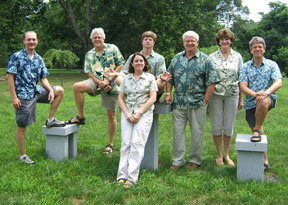 This
summer, the NEMO team’s keen interest in sartorial splendor
has translated to a “Hawaiian Shirt Friday” policy. The
policy, unabashedly stolen from the NOAA Coastal Services Center, has
been informally in effect for the past two summers. However, following
the National NEMO team’s visit to Hawaii in February and its
subsequent shirt-related inspiration, strict implementation and enforcement
of the policy is now the rule. Of particular interest to the NEMO team
are two critical issues: (1) does one wear one’s Hawaiian shirt
tucked in, or out?, and; (2) Is the goal to have the loveliest or the
tackiest design possible?
This
summer, the NEMO team’s keen interest in sartorial splendor
has translated to a “Hawaiian Shirt Friday” policy. The
policy, unabashedly stolen from the NOAA Coastal Services Center, has
been informally in effect for the past two summers. However, following
the National NEMO team’s visit to Hawaii in February and its
subsequent shirt-related inspiration, strict implementation and enforcement
of the policy is now the rule. Of particular interest to the NEMO team
are two critical issues: (1) does one wear one’s Hawaiian shirt
tucked in, or out?, and; (2) Is the goal to have the loveliest or the
tackiest design possible?
04/05 The National NEMO Network’s Fourth NEMO University Conference is a Success
The National NEMO Network held their fourth NEMO University conference, NEMO U4ia, in Washington, DC April 4-7. The conference is an opportunity for representatives from NEMO programs across the country to come together to share experiences and expertise, network with federal agencies, and share new educational tools and approaches.
The conference was attended by 53 NEMO program staff from 29 states, as well about 15 federal agency staff from USDA, NOAA and EPA. It featured pre-conference topical and Geospatial training sessions, regional collaboration discussions, a program overview poster reception, and topical discussion groups. Most important, it featured “success and survival stories” from programs around the Network, who shared both their bottom-line successes with communities, and their strategies to survive these tough fiscal times.
4/05 AZ NEMO's Kristine Uhlman is named to the State's Water Protection Fund Commission
The Hub was impressed to learn recently that Kristine Uhlman, coordinator of the Arizona NEMO Program, has been named by Governor Janet Napolitano to the State's Water Protection Fund Commission. The Commission oversees an annual pot of funds for measures to protect water of sufficient quality and quantity to maintain, enhance, and restore rivers and streams and associated riparian habitat. For more information on the fund, visit: www.awpf.state.az.us/
The appointment demonstrates how valuable Kristine and the AZ NEMO program are to water quality (and quantity) protection in Arizona.
Nice work Kristine and Congrats!
3/05 New York Sea Grant Adds Two New Team Members
New York Sea Grant is very pleased to announce the addition of two new team members.
Christy Witters has joined the NEMO program as a Water Quality Educator. Christy has a very strong background which includes a Master's Degree in City and Regional Planning from the University of North Carolina. In addition,as a Pollution Prevention Specialist, Christy managed the Stormwater Pollution Prevention Program for the New England Army Reserve, which entailed the implementation of stormwater management plans at 50 Army Reserve facilities.
Steven Mikulencak comes to New York Sea Grant with a Master's in City Planning from Cornell University and experience as an Intern with the Regional Plan Association, which included facilitating public processes such as local economic development, town planning and greenway design. Additionally, Steven's background includes time spent as a GIS analyst in Seattle with responsibility for data management,technology upgrades and map production.
Feel free to drop Steven a note at sam225@cornell.edu.
02/05 AWARE Colorado's Toolkit for Local Officials is Released
AWARE Colorado’s new guide, "Water Protection Toolkit for Local Officials: Connecting Land Use with Water Quality," was developed to help land use decision makers better understand proven approaches to protect water quality through community planning.
The toolkit has ideas about ways to safeguard water resources, examples from Colorado communities, and suggested resources for learning more. With sections on the water and land connection, reducing impervious surfaces, collaboration, planning and zoning tools, reducing transportation-related impacts, improved landscaping and regulatory programs, the toolkit raises awareness of the importance that planning plays in protecting the state’s water bodies.
Contact: Cynthia Peterson or visit www.awarecolorado.org/toolkit.pdf.
02/05 The History of NEMO University
As the NEMO Nation prepares to gather for our fourth conclave, some brief and painless history might be in order for those new to the "NEMO U" experience.
The first NEMO U (Oct. 2000) was very much a home-cooked affair, held in Haddam, CT, home to the Hub. To the 20 states making the scene, NEMO U posed the question, “Do we really want to do this Network thing?” The answer came back as a resounding “Yes!”
NEMO U2 (Jan. 2002) brought us to the technological marvels of the NOAA Coastal Services Center, and the charming restaurants and back streets of Charleston. At U2, we reconfirmed that NEMO was about more than impervious surface reduction, and that we had some great partners out there. Success stories were starting to trickle in, and it looked like the Network was here to stay for awhile. Most important, we discovered some interesting locations for the NEMO tattoo.
U3 seems like yesterday, but it was May, 2003—almost two years ago. At U3, the subtheme was “It’s not just about Connecticut anymore—no, really!” We had significant, multi-day participation by a goodly number of our federal agency supporters from EPA, NOAA and USDA. We had some Network-wide stories to tell about smart growth/open space planning and the ISAT tool. And for one evening, we peopled the Branford House mansion and assumed the trappings of a more genteel era (it didn’t work).
U4 is almost here. The underlying focus of the conference, “Succeeding to survive or surviving to succeed, (whatever).” Despite dwindling funding opportunities and overwhelming workloads, the Network has grown and NEMO programs have found a way to both succeed and survive. U4 will highlight those stories and seek to explore how we can all continue to succeed and/or survive.
02/05 New Network Members
We are happy to announce the arrival of two new NEMOids. The University of Illinois Extension Service launched Illinois NEMO in the fall. The effort will be led by Susan Meeker, Extension Educator, and focus initially on the Peoria area. In addition, the University of Hawai’i Sea Grant Program has recently decided to join the Network and plans to launch a program focused on the islands of Maui and Hawai’i. (Don’t tell them, but we are already targeting them to host NEMO U5.)
02/05 CT NEMO’s New Publication, Putting Communities in Charge
CT NEMO recently printed its first official impact report dedicated to the work of the NEMO Program in Connecticut. The report describes the origin, objectives and progress of the program and includes a number of exciting new initiatives that have begun during this past year.
The main body of the Report, however, is given over to portrayals of selected towns that have worked with NEMO, and the ways that these towns are taking charge of their community’s future development patterns. The report profiles Old Saybrook, Waterford, Woodstock, Salem, Central Naugatuck Valley, Watertown, East Haddam, Candlewood Lake Authority and Stonington. The examples detailed in the report, while they represent only a portion of the good work being done around the state, demonstrate the power of local citizens to bring about positive change in their communities.
The profiled areas (Old Saybrook, Waterford, Woodstock, Salem, Central Naugatuck Valley, Watertown, East Haddam, Candlewood Lake Authority and Stonington) are available as individual .pdf files for easy online viewing at the CT NEMO website Publications section.
02/05 Northland NEMO's "View from the Lake" Program is a Success
The Northland NEMO folks launched their “View from the Lake” program this past summer. Through this program they took land use decision-makers and other interested travelers on 21 different three hour tours (minus Gilligan) aboard a 60 foot tugboat. The boat trips provide a great opportunity to demonstrate the impacts of land use on water quality from a different vantage point. The program proved so popular, they are already receiving requests for next summer’s tours.
(bottom) Northland NEMO's Jesse Schomberg speaks with passengers aboard the L.L. Smith JR (Top).
02/05 Nevada NEMO Coordinator, Sue Donaldson, Honored
Through some unrelated google searching, the Hub inadvertently discovered that Sue Donaldson, coordinator of the Nevada NEMO Program, was awarded the Golden Pinecone award for her outstanding environmental education programs. The ever humble Sue said "This award means as much or more than any other that I've received because it is coming from the community." In case you were wondering, the award is not an actual golden pinecone.
For more information on the Nevada NEMO Program, check out the Nevada NEMO website.
01/05 NEMO
Featured in the Earth Imaging Journal
November/December
2004 Vol.1, No. 6
An article about CLEAR and NEMO was recently published in Earth Imaging Journal, a fairly new high-profile publication in the remote sensing world. EIJ is published by private sector remote sensing interests, and is not a peer-reviewed journal. However, their interest in our work (they solicited the article), and the fact that they put it on the cover of the hard copy journal, is a good sign indicating our growing national recognition. Interestingly, we assumed that they wanted to know all about our latest CLEAR research, but the Editor kept asking us for more about NEMO and the on-the-ground results of our work. Thus, there are nice breakout boxes on both CT and National NEMO. The e-article is at: http://www.eijournal.com/Local_Decisions.asp
09/04
- Water Quality Planner Joins Sea Grant Team
09/04
- South Carolina NEMO Website Wins Award
08/04
- We're Famous!
08/04
- U4-ia Begins!
08/04
- 8/04 Arizona NEMO, the First Semiarid-Focused Program
08/04 - Vermont Joins the Network
07/04
- Dave Dickson is the New National NEMO Network Coordinator
06/04
- NEMO's Great Lakes Programs Featured in "Keeping it On
the Land"
06/04
- Northland NEMO's New "Natural Resource Information" Educational
Materials
03/04
- John Rozum Leaves the Network
03/04
- Around the Network
03/04
- Hub Stays Funded
03/04
- Tracking Connecticut's Changing Landscape
03-04
- Arizona NEMO Has a New Log
The following article is from the North Carolina Sea Grant Marine Extension News Winter 2004 issue.
09/04 Water Quality Planner Joins Sea Grant Team
Timing is everything. And, it’s no coincidence that Kate Ardizone has joined North Carolina Sea Grant as water quality planning specialist when coastal communities are revising their land-use plans under new Coastal Area Management Act (CAMA) rules.
The new rules, adopted by the Coastal Resources Commission in 2002, address a variety of sustainable growth and development issues that link land use to coastal water quality. In particular, local governments must address nonpoint source pollution and its impact on water quality as part of long-range planning. Nonpoint pollution sources include erosion >from disturbed land, failing septic systems, as well as stormwater runoff from hardened surfaces or nutrient-rich agricultural and residential tracts.
Ardizone will play a supporting role to local governments and citizens taking steps to comply with the CRC planning guidelines. Ardizone’s position is being supported for a two-year period by Sea Grant and the N.C. Department of Environment and Natural Resources’ Division of Water Quality (DWQ).
"My focus is on serving the coastal communities," Ardizone says.
Still in a listening mode, she is attempting to identify the greatest needs. It’s a first step toward helping local governments develop strategies that address land use and water quality.
"There is no one-size-fits-all approach," she says. But there are a host of natural resource-based planning techniques, high-tech and low-tech solutions for coastal communities to consider.
An opening dialogue, for example, could be in helping communities identify natural features, their ecological function, and how they might figure in land-use planning.
Ardizone is well prepared to facilitate such public discourse. In 2000, she served as an outreach program associate at the National Oceanic and Atmospheric Administration’s Coastal Services Center in Charleston. There, she was project leader in developing "Engaging Communities: Participatory Strategies for Coastal Managers," a CD-ROM that features examples of ways to improve the public’s involvement and understanding of environmental issues.
Most recently, Ardizone was a NOAA Coastal Management Fellow, working for two years with the Michigan Department of Environmental Quality’s Coastal Management Program. She co-authored "Filling the Gaps: Environmental Protection Options of Local Governments," a guidebook for local officials challenged to balance resource protection and economic prosperity.
The book was the basis for regional workshops Ardizone conducted on topics such as ecological processes, natural resource-based planning techniques, regulatory options and implementation tools.
Ardizone believes North Carolina is ahead of the game because of the framework that exists for localities to adopt environmentally sensitive land-use plans. CAMA was adopted more than three decades ago as a mechanism to protect coastal resources.
Still, in the face of aggressive coastal growth, there is a lot at stake, says Walter Clark, Sea Grant’s coastal communities and policy specialist.
"Kate’s technical assistance should be especially well received in coastal communities that may not have the resources to plan and implement CAMA guidelines," he adds.
"The goal of this position is to increase the internal capacity of the local governments to perform these tasks on their own in the future," explains DWQ’s Gloria Putnam.
Ardizone will consult with Clark and Putnam, as well as the N.C. Division of Division of Coastal Management (DCM) and N.C. Cooperative Extension Service to identify target audiences for outreach and education efforts. These audiences could include elected officials, developers, professional planners and interested citizens.
When requested, she will assist in reviewing, or suggesting improvements to water quality components of land use plans.
Recognizing that it’s not enough to turn a community on to best management practices without regard to funding constraints, Ardizone will help identify proposed water quality improvement projects that may be eligible for funding.
She adds, "Many solutions to water quality problems can be achieved through appropriate planning, policy enforcement and citizen participation with little or no additional cost to the community."
Ardizone maintains an office at North Carolina State University’s Center for Marine Studies at Morehead City. She can be reached at 252/222-6316 or ardizonek@ncsu.edu.
09/04 South Carolina NEMO Website Wins Award
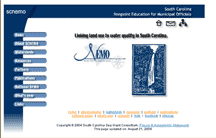 Clemson
Extension Web Site Communications Award
Clemson
Extension Web Site Communications Award
The South Carolina Nonpoint Education for Municipal Officials (SC NEMO) Website, a S.C. Sea Grant Extension Program project, recently won a 1st Place award for content and graphic design. Content was written by April Turner and site design was by Patty Snow. The award is sponsored by the S.C. Association of County Agricultural Agents. For more information, visit the SC NEMO site. http://www.scseagrant.org/scnemo.htm.
08/04 We’re Famous!
The National NEMO program is highlighted in the preliminary report of the U.S. Commission on Ocean Policy, the first presidential commission to review and make recommendations on national ocean policy since the Stratton Commission report was released in 1969.
Recognizing that “land use decisions dramatically affect the health of coastal waters,” the Commission applauds NEMO for educating land use officials about the effects of their actions and policies on water quality and recommends an expansion of such efforts. Specifically, the Commission recommends that: State and local governments should revise their codes and ordinances to require land use planning and decision-making to carefully consider the individual and cumulative impacts of development on water quality, including effects on stormwater runoff. The U.S. Environmental Protection Agency(1) and other appropriate entities should increase outreach programs that provide local land use decision makers with the knowledge and tools needed to make sound land use decisions that protect coastal water quality(2). (Recommendation 14-11.) A final report has been approved by the Commission and is expected to be released this fall. This recommendation is certainly a testament to the importance of the efforts of all the NEMO Network members and partners in their communities. The full report can be found at website www.oceancommission.gov.
Note
1: The Network Hub provided comments to the USCOP that EPA should
be joined by NOAA, USDA and NASA in the Recommendation, just as
it was in the preamble.
Note 2: According to the USCOP website, key changes to the Preliminary Report
include a recommendation for “significant expansion of the National Sea
Grant College Program” (!!)
 08/04 U4-ia
Begins!
08/04 U4-ia
Begins!
Euphoria—however spelled—is the watch-word of the day here at the Network Hub. For one, with the addition of Dave Dickson as our new National Network Coordinator (see article below), we are finally up to full strength at all NEMO line offices. As I ride (once again) into the sunset, let me say that I have enjoyed my brief stint as the Interim Part-time Provisional Network Coordinator. It gave me a renewed appreciation for the great work that you folks are doing out there, and what we yet might accomplish as a network.
Second, of course, we are gearing up for NEMO U4, to be held April 4-7 in Washington, DC. Between euphoria and U4-ia, a whole lot of reality will set in, what with the many details of conference sessions, field trips (can we find a boat trip?), receptions, etc. U4 will have a Big City feel, yet keep the homespun quality that has characterized NEMO U in the past. As John Rozum (remember him?) said to me this spring, “the agenda of NEMO U is almost irrelevant.” By this, we mean that NEMO U is not about topical training, but about strengthening the bonds of communication and collegiality that keep the NEMO Network alive, well and fun to be a part of.
So, I entreat, encourage and otherwise invite all of you to attend U4 in April. I think you’ll be surprised at the quality and diversity of what your Network colleagues have been up to. We’ll have new Network members to indoctrinate, community- level impacts to highlight and, of course, ample interstices for socializing. - Chet Arnold
08/04 Arizona NEMO, the First Semiarid-Focused Program
- article by Kristine Uhlman
Arizona NEMO is the first attempt to adopt the national NEMO approach to conditions in the semiarid, western United States. For Arizona, the program is structured within a watershed-defined template and we are focusing our educational outreach efforts on the policy makers, planners, and land use decision makers impacted by nonpoint source water quality issues—including the Stormwater Phase II MS4 communities. GIS-based tools, such as the Automated Geospatial Watershed Assessment (AGWA) tool are being used to illustrate the effects of land use change on runoff and erosion, and to model sediment load—the principal nonpoint source pollutant in Arizona.
All four of the deserts of North American occur in Arizona, and with a geographical extent equivalent to the combined size of the states of Maine, New Hampshire, Vermont, Massachusetts, Connecticut, Rhode Island and New York, stormwater could not be more distinct than from other parts of the country.
GIS-based hydrologic watershed modeling software has been developed by the USDA-ARS Southwest Watershed Research Center and the University of Arizona in collaboration with the EPA’s National Research Laboratory. The Automated Geospatial Watershed Assessment software (AGWA) performs hydrologic model parameterization and results visualization for existing watershed scale hydrologic simulation models of stormwater runoff. AGWA allows the user to spatially visualize changes in hydrologic response through the use of remotely sensed land cover scenes. GIS-AGWA modeling has assisted in characterizing stormwater flow response to urbanization within the San Pedro River Watershed (Miller, et. al., 2002; Hernandez, et. al., 2003), and to model.
Satellite imagery of the San Pedro Watershed taken in June of 1973, 1986, 1992 and 1997, exhibited significant land use change and urbanization, especially within the subwatershed running through the developing community of Sierra Vista. The Sierra Vista subwatershed exhibited profound changes in land use, with nearly a 415% increase in urban area and 38% decrease in desert scrub and grassland. Runoff and sediment yield have been increasing in the urban subwatershed, and flashier flood response has been observed. It is expected that the decreased infiltration capacities and roughness associated with urbanization would increase the potential for localized large-scale runoff and erosion events, but this was not found to be true.
1973
Images above: Land cover change on the Upper San Pedro, after Miller, et al., 2002. (The San Pedro Watershed straddles the Arizona, Mexico boundary, shown as a horizontal line in each of the figures above.)
The Sierra Vista simulations suggest that the increased erosion observed to occur within an arid watershed undergoing a transition to urbanization may be due to more than urban-generated sediments. Sediment starved urban storm runoff due to the increase in impervious surfaces may be responsible for excessive down cutting in ephemeral streams and washes. Without sufficient sediment load, ephemeral streams will down-cut and erode the stream bed aggressively, contributing to the transport and re-distribution of streambed sediment. In the natural south west desert setting, intermittent storm flow acts as a conveyer belt, reloading with sediment with each storm event and transporting sediment on down-gradient. The GIS/AGWA modeling simulations of the Sierra Vista urban subwatershed for the 5-year, 30-minute design storm calculated runoff increasing by 177%, and sediment load increasing by 851% in response to urbanization over the 24 years between 1973 and 1997.
Hydrologic modeling and watershed assessments of the Upper Gila, Bill Williams, and Verde Watersheds are nearing completion, and examples from this work will be posted on the Arizona NEMO website in the future.
Contact
Kristine Uhlman, Senior Program Coordinator, with any questions
or comments about the Arizona NEMO Program at kuhlman@ag.arizona.edu or
by phone at 520-621-5951. www.srnr.arizona.edu/nemo
08/04 Vermont Joins the Network
We are pleased to welcome Vermont’s newly funded NEMO Program. Vermont’s program is headed by Jurij Homziak, Extension Assistant Professor, from the Lake Champlain Sea Grant Extension Project UVM, located in Burlington. Email Jurij at jurij.homziak@uvm.edu.
07/04 Dave Dickson is the New National NEMO Network Coordinator
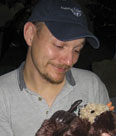 David
comes to UConn from Washington, DC, where he was the Program Manager
for the National Association of Local Government Environmental Professionals
(NALGEP), a not-for-profit organization that represents local government
personnel responsible for ensuring environmental compliance and developing
and implementing environmental policies and programs.
David
comes to UConn from Washington, DC, where he was the Program Manager
for the National Association of Local Government Environmental Professionals
(NALGEP), a not-for-profit organization that represents local government
personnel responsible for ensuring environmental compliance and developing
and implementing environmental policies and programs.
Dave organized and coordinated a number of initiatives for NALGEP, among them the “Smart Growth for Clean Water” project, a partnership with the Trust for Public Land, U.S. EPA, and the U.S. Forest Service that first brought NEMO to his attention (and visa-versa). Recently, he’s also been in charge of the Brownfield Communities Network, a national network of local communities working to demonstrate how the cleanup and reuse of contaminated property can be an effective tool for community revitalization. The NALGEP website says that the Brownfield Communities Network “…is working to harness the substantial knowledge, expertise, and experience of the nation’s leading brownfields communities developed during the past decade and export it to their peers.” Sound familiar?
Dave’s experience with national coordination and community-level projects will obviously stand him in good stead in his new job here at the Hub. As an added attraction, he holds a JD from the University of Colorado School of Law in addition to his Masters from the same University’s Graduate School of Public Affairs, so he will be available to (literally) bail out some of his new colleagues, in the unlikely case that any untoward legalistic activities arise.
Dave will be steeping himself in NEMO-ology over the summer, and begin to acquaint himself with all of you by summer’s end. He notes that “Hopefully, all the nuts out there in the NEMO Network aren’t quite so cranky and unreasonable as Rozum and Gibbons say they are!” [note: Dave was unavailable for a direct quote, this quote was generated using sophisticated verbiage approximation software].
Contact Dave at 860-345-4511. Email david.dickson@uconn.edu.
06/04 NEMO's Great Lakes Programs Featured in "Keeping it On the Land"
NEMO has been featured in the latest issue of "Keeping it on the Land," a newsletter of the Great Lakes Commission. The newsletter not only features a lead article on NEMO with a Great Lakes emphasis, but there is also a separate feature on the Lake Superior project. The article can be found at: www.glc.org/basin/pubs/keeping/pdf/0601-screen.pdf.
06/04 Northland NEMO's New "Natural Resource Information" Educational Materials
 Northland
NEMO, the Minnesota Department of Natural Resources and the Dakota
County Soil and Water Conservation District are pleased to introduce
two new products to help local communities incorporate natural resources
into their activities:
Northland
NEMO, the Minnesota Department of Natural Resources and the Dakota
County Soil and Water Conservation District are pleased to introduce
two new products to help local communities incorporate natural resources
into their activities:
The Brochure, "A Quick Guide to Using Natural Resource Information" and companion CD-rom "Guide to Using Natural Resource Information in Local Decision Making" are now available in hard copy from the DNR (see below) or in electronic form at the DNR's website: www.dnr.state.mn.us/nrig.
The Guide illustrates how using natural resource information in the local land use planning process can ensure that land use decisions are made in an environmentally sensitive and fiscally responsible way. It outlines a step-by-step Natural Resource-based Planning Process designed to provide planning guidance for people with a wide range of backgrounds and interests, including: local officials, local staff, concerned citizens, developers and other land use professionals.
The Quick Guide brochure serves as an introduction to the much more in-depth CD rom, which provides details about how to do a natural resource inventory, including where to find critical pieces of natural resource data that may already exist for your community.
The CD rom also includes numerous case studies of how communities have used natural resource information in a wide variety of ways.
For more
information or to order the guide on CD ROM, contact: Julie
Westerlund, Community Assistance Coordinator
e-mail: julie.westerlund@dnr.state.mn.us -
tel. 651.772.7938.
3/04 John
Rozum Leaves the Network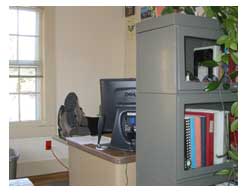
As most of you know, John Rozum has stepped down as National Network Coordinator to head up the Connecticut NEMO Program. From our perspective, it's really great news. After a lengthy period with no one at the helm, it was way past time for the Connecticut program to get its act together, and John is just the man for that. And, with the evolution of the Network to a new phase in its development, it's not a bad time to make this change.
For the record: John did a fabulous job, and it is very likely that without John there would be no NEMO Network. The numbers tell part of the story—from 5 to 33 programs in his 4-year tenure. However, the true importance of John's contribution is that few could have delivered the unique combination of topical knowledge, teaching prowess, hard work, imagination and humor that cajoled all you folks into getting into NEMO.
Of course, here at the Hub we needn't get all sentimental about John's departure, because, like gum stuck to the bottom of your shoe, he's still around. And because of that, the interim period between Coordinators will be less painful, both for you and for us. Kara, as always, is steadily crossing things off the Network to-do list, and I will be helping with the national work until our next Coordinator, for whom we are actively searching, comes on board. About the only major impact is that we feel the need to postpone NEMO U-4 for several months, from this Fall to the Jan-Feb. period of 2005. We hope to make the wait worthwhile. In the meantime, call me anytime with your Network-related needs. -Chet
03/04 Around the Network
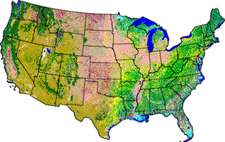 Maine -
The NEMO program has a new coordinator. LaMarr Cannon brings
with her a solid background that includes both technical and outreach
experience. She was most recently employed at the Maine DEP, where
according to our well-placed sources, she was considered a star employee.
Prior to that, she earned a masters degree in environmental engineering
from Oregon State University, where she worked as a Research Assistant
on a project that focused on modeling stormwater and developing low
impact development options. She also spent a couple of years doing
outreach with a Soil & Water Conservation District in Oregon.
Maine -
The NEMO program has a new coordinator. LaMarr Cannon brings
with her a solid background that includes both technical and outreach
experience. She was most recently employed at the Maine DEP, where
according to our well-placed sources, she was considered a star employee.
Prior to that, she earned a masters degree in environmental engineering
from Oregon State University, where she worked as a Research Assistant
on a project that focused on modeling stormwater and developing low
impact development options. She also spent a couple of years doing
outreach with a Soil & Water Conservation District in Oregon.
North Carolina - Kate Ardizone will take the helm of a newly funded effort in coastal North Carolina. Some may remember Kate from NEMO U2 in Charleston, where she attended as a representative from Michigan. Kate has worked as a Coastal Services Center fellow for the Michigan Department of Environmental Quality for the past two years, where she spent a lot of time talking to local township and county officials about alternative stormwater practices. Kate published a manual for Michigan local officials entitled, Filling the Gaps: Environmental Protection Options for Local Governments, that is now being used as the basis for similar efforts in other states. In North Carolina, Kate will be coordinating a collaborative effort between the Sea Grant and Cooperative Extension programs, working in broadening outreach efforts to coastal municipalities.
Pennsylvania - Another new program under the aegis of the PA Sea Grant program will be staffed by Dave Skellie and Sean Rafferty. Dave, the former director of the Erie County Planning Department, will oversee the project, while Sean, a recent graduate of Penn State Erie, will be getting out to the towns and making presentations. The Pennsylvania Sea Grant effort received 3-years of support from the PA DEP.
Arizona - Kristine Uhlman is the new coordinator for the newly-formed Arizona NEMO Program based in the University of Arizona's Cooperative Extension. Besides having one of the coolest NEMO logos, the Arizona NEMO Program is focusing on needs assessment of watershed stakeholders, development and implementation of workshops and other outreach media, and working on various mitigation projects. Kristine comes to this position following 28 years in hydrology, including employment with the US Geological Survey as well as several national and international consulting firms with projects in mine-site restoration, water resource management, environmental site clean-up, and expert witness testimony on topics of contaminant hydrogeology under Natural Resource Damages litigation. So, you now know where to send all your hydrology questions!
03/04 Hub Stays Funded
Your Network Hub will stay in business for several more years, thanks to the continued support of our federal agency partners. The University of Connecticut was awarded a four-year continuation for national facilitation of the NEMO Network from the USDA CSREES Water Quality Program. Another four-year commitment was made through a grant award from the EPA Office of Water's Nonpoint Control Branch. Thanks to both of these agencies for their continued support.
03/04 Tracking Connecticut's Changing Landscape
The UConn Center for Land use Education And Research (CLEAR), the parent organization for NEMO, has made use of cutting-edge remote sensing techniques to provide data about how the Connecticut landscape has changed since 1985, with a special emphasis on the growth of developed land. The natural forested land of the Northeast, almost completely converted to farmland only a hundred years ago, is now undergoing a transformation to an urban/suburban landscape. With these changes come a number of concerns about the environmental, social and economic impacts of development, some of which have become the subject of intense debate across the state. Connecticut's Changing Landscape, a project under development at UConn for the past two years, is an attempt to bring research-based information and education to these debates. Through a website and NEMO outreach programs, this information is being provided to Connecticut's local land use decision makers and other interested parties across the state. It is the goal of the Center to help create a sound foundation on which to build better land use plans, policies and practices that can accommodate growth while protecting natural resources, community character, and other things that we hold dear about our communities.
To view the land cover data visit the CT's Changing Landscape section of the CLEAR website.
03/04
Arizona NEMO Has a New Logo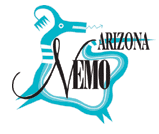
Found in the spiritual mythology of the ancient Zuni, Hopi and Pueblo cultures, Avanyu is the Hopi name for the water serpent, “one who lives in the water below the earth, one who carries us through the water of change.” The sacred Avanyu lives in streams and is feathered with a turquoise horn growing from the middle of its forehead. The horn moves, sending rain for crops. When the Avanyu creeps on the ground and snaps its tail, it causes thunder, and when its tongue strikes out of it mouth, it causes lightening. If you see the Avanyu it will bring luck and good health, and it means there is water nearby or that it will rain soon. The symbol of Avanyu signifies the prayer for and representation of water. According to tribal wisdom, those who poison the water must face Avanyu's fiery revenge.
11/03
- Ohio NEMO takes a Spin
08/03
- Announcing Chloe Marshall
08/03
- New States Join the Network
08/03
- Network Workshops
08/03 - National Geospatial Datasets Web
Page
08/03
- Maine NEMO Newsletter
08/03
- NEMO U3 Haiku Contest Winners
06/03
- NEMO U3 a Great Success
03/03
- Network Progress Report published
03/03
- New states join the Network
03/03 - Ohio
NEMO Holds Statewide Stormwater Conference
03/03 - Northland NEMO Hires New Coordinator
11/03
Ohio NEMO Takes a Spin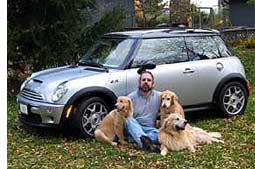
Ohio NEMO Director and his staff are shown taking a breather from an exhaustive outreach and stick retreiving schedule with their brand new staff car. The OH Program has unsuccessfully petitioned the Network Hub to change the NEMO acronym to mean Notice Each Mini Owner (to which we assume they are refering to the car). The NEMO Hub has taken no official position on the model of car deemed appropriate for a successful NEMO program, nor the breed of dog most effective in reducing nonpoint pollution (research is still underway, see future fact sheets). Still, the OH NEMO team seems pleased with their new vehicle and are now in the market for an effective hair removal tool.
 8/03
Announcing Chloe Marshall
8/03
Announcing Chloe Marshall
We are happy to announce the birth of Chloe Marshall to Alabama NEMO coordinator Eve Brantley (email the new mom) on August 9, 2003. Chloe weighed in at 6 lbs, 15 ozs and was 21 inches. Claims a proud mother Brantley, "That weight stuff used to mean nothing to me, but now I'm all over baby weights and inches." Both mother and baby are doing well and anticipating the arrival of their infant NEMOware.
8/03 New States Join the Network
California - Formally called the CA NEMO Partnership, this group is coordinated by the CA Coastal Commission and Mission Resource Conservation District. Last we heard, CA coordinators Tracy Duffey and Cindy Mallet were not on the ballot for governor.
Louisiana - The LA NEMO program is led by the LSU Extension and the Louisiana Sea Grant program. Still in the pilot phase, this project is focusing on parish officials in a coastal watershed.
North Carolina - This joint project between the North Carolina Sea Grant program and NC State University, builds on the success of some existing efforts. Focusing on coastal North Carolina, the organizers are planning to have Chet and John down in October to help with project scoping and to lead the assembled in the project fight song.
Utah - This prgram also builds on existing efforts out of Utah State University's Extension program. Look for more information about this program in upcoming issue.
8/03 Network Workshops
Alabama NEMO - Watershed Academy: Principles of Water Quality Monitoring, Planning, and Restoration to be held on March 1-4, 2004 in Fairhope, Alabama. This workshop is sponsored by the USDA CSREES Southern Region Water Quality Program. To learn more or reserve a space visit www.aces.edu/waterquality/streams/academy.htm or contact Eve Brantley.
Maine NEMO - Stormwater Management in Cold Climates: Planning, Design and Implementation to be held on Nov. 3-5, 2003 at Holiday Inn by the Bay in Portland, Maine. This first-of-its-kind North American conference will focus specifically on the challenge of managing stormwater in cold climates. Leaders in the field will be featured, presenting the latest information and technologies addressing stormwater in cold climates. To learn more or reserve a space visit www.cascobay.usm.maine.edu/coldsw.html.
Ohio NEMO - The Streams Channel Protection and Restoration Conference to be held on October 6 and 7, 2003 in Columbus, Ohio. Learn about all aspects of stream restoration and design from some of the leading experts in the field and help kick off the new “NEMO for Streams” training module. To learn more or reserve a space visit www.ag.ohio-state.edu/~streams
8/03 National Geospatial Datasets Web Page
If you've ever felt the need for geospatial data on a broad geographic scale, or needed to compare your area with other areas around the country, you should take a trip to the Geospatial National Datasets web page, created as a collaboration of CT NEMO, the UConn Geospatial Technology Program and your friendly NEMO Network Hub. Emily Wilson and Sandy Prisloe have done a great job of not only directing you to these NEMO-friendly datasets, but providing value-added, plain English information about such things as cost, scale projections, availability, downloading quirks, etc. Check it out: clear.uconn.edu/geospatial/datasets/.
8/03 Maine NEMO Newsletter
For those of you who haven't seen it, go to the Maine NEMO website and download their first-ever newsletter! This 6-page periodical contains articles about ISAT, urbanization, Phase II and, of course NEMO U3. Nice work, Jodi! www.mainenemo.org/publication.htm
8/03 NEMO U3 Haiku Contest Winners
For no apparent reason that we can discern, we held the world's first stormwater haiku contest at NEMO U3. Haikus are extremely simple verses to write. Generally consisting of 17 syllables, they test your ability to convey meaning in the most parsimonious way possible. The prize for our winners? The honor of being published (here, that is).
First Place Winners
Waters take all—off land off street
Land and water soon meet.
-Jessica D’Ambrosio (OH)
Huddle and fall from the sky:
Orgy to the sea.
-Kevin Dobbs (KS)Third Place Winners
Wash the car, water the lawn -
then it starts to rain.
-Tracy Duffey (CA)
who knows what flows on this beach
solutions we teach.
-Cal Sawyer (SC)
6/03
NEMO U3 a Great Success!
The third NEMO University was held in mid-May on the beautiful coastal campus of UConn in Groton, CT. The close relationship of the Network Hub and the Powers That Be was demonstrated by the fact that U3 took place on the only three sunny days in May in Connecticut. We know that it's mind-boggling to contemplate, but U3 was even more successful - and fun - than its predecessors! 23 state NEMO programs participated in a chock-full agenda that included updates from the floor, field trips, topical interludes, and break-out discussions wrapped around boat trips, poster receptions and croquet battles on the expansive lawn of the Branford House Mansion (two satisfied attendees pictured). The theme of the conference was "distributed leadership" of the Network, i.e., that a lot more folks than the Connecticut program are "getting it done." We also had much appreciated participation from our agency colleagues from NOAA, EPA and USDA. Watch for the upcoming conference CD - pictures, video, presentations, Haiku contest winners and much more.
3/03
- Network
Progress Report Published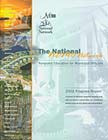
The first ever report on the progress of the National NEMO Network was published in March 2003. The report details the evolution and organization of the Network and highlights a dozen Network projects, focusing on the impacts resulting from NEMO programming in their states. The colorful 40-page booklet was written and edited by the Network Hub and the state NEMO program coordinators and was expertly designed by Network Communicator Kara Bonsack. If you have not received a copy of the report, they can be ordered from the NEMO website. Thanks to all who contributed to this publication!
3/03
-New
States Join the Network
The Network continues to grow, stretching ever westward, with new states in Arizona, Colorado, Mississippi and Nevada. The Arizona NEMO Program is led by Deb Young of the University of Arizona Cooperative Extension System and will focus on several issues unique to the arid Southwest. The Colorado project, coined AWARE (Addressing Water And natural Resource Education) Colorado, is coordinated by Loretta Lohman of Colorado State University Cooperative Extension and by Cynthia Peterson of the CO League of Women Voters. In Mississippi, the Department of Environmental Quality is leading the charge under the direction of James MacLellan, an actual professional engineer (don't worry James, we don't hold that against you). Last, but not least, Nevada is gambling on NEMO to help identify and address a number of water related issues, awarding a Section 319 grant to Susan Donaldson, a water quality education specialist for University of Nevada Cooperative Extension. Congratulations to all and welcome to the Network.
3/03 -Ohio NEMO Holds Statewide Stormwater Conference
Pushing back technical frontiers, the Ohio NEMO Program held an internet simulcast conference this January entitled, Workshop on Developing an Effective Stormwater Management Program Using: Best Management Practices, Performance Standards, and Pollution Credit Trading. The workshop included experts from both the federal and state governments, as well as public sector practitioners. The workshop was co-sponsored by OH NEMO's many partnering agencies, including the County Commissioners Association, OH Township Association, OH Sea Grant, among many others. If you are interested in learning more, click on over to OH NEMO's well-stocked website (nemo.osu.edu) and view the workshop in it's entirety on-line, including a segment where coordinator Tim Lawrence is wearing a very nifty tie. Nice work, Tim!
3/03
- Northland
NEMO Hires New Coordinator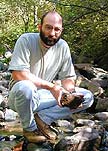
Northland NEMO hires new coordinator - Jesse Schomberg has been hired as Minnesota Sea Grant's new NEMO coordinator for the northern Minnesota region. This rock-climbing father of two will work with communities in the Western Lake Superior Basin spreading the NEMO gospel far and wide. Schomberg earned a bachelor's degree at the University of Minnesota Duluth, and went on to earn a master's degree studying aquatic invertebrates at Idaho State University. Jesse has already gone through the traditional NEMO initiatory activities (a painful but important team building exercise), being a participant in last fall's ISAT training. Join us in welcoming Jesse to the Network. (Special thanks to UMN Sea Grant Program for the photo and info on Jesse)
11/02
- New National Geospatial Datasets Webpage
11/02 - EPA and NEMO Network Team Up on Smart Growth
Through Open Space Planning
11/02 - ISAT, a New Geospatial Analysis Tool
09/02
- Development and Enhancement of Coastal NEMO Network Projects
09/02
- New National Network Logo!
09/02
- NEMO Named the Group of the Month
09/02 - NEMO Featured in NWQEP
11/02 - New National Geospatial Datasets Webpage
CT NEMO, the National NEMO Network and the Geospatial Technology Program announce the posting of a new web page: National Geospatial Datasets. A compendium of nationally available geospatial information, this site provides descriptions of the data, how to download and view the information, and other tips and advice. As far as we know this is the first time these various sources of data have been placed together in one, easy-to-use web page. You can find this page either from the link below, or from the Members Resources button on this website.
http://clear.uconn.edu/geospatial/datasets/
11/02 - EPA and NEMO Network Team Up on Smart Growth Through Open Space Planning
In an exciting new partnership with the EPA "Smart Growth" office, the Hub is training selected Network projects in conducting educational programs for local officials on open space planning and natural resource inventories. Learn more about the project by viewing our latest Network Project Update. Smart Growth Through Open Space Planning (PDF - 45k)
11/02 - ISAT, a New Geospatial Analysis Tool
ISAT is an ArcView 3.x extension designed to estimate the percent area of a watershed (or another user specified geographic area) that is covered with impervious surfaces and to display the results in the familiar NEMO green, yellow and red colors indicating possible water quality impacts. The extension, written by staff at the NOAA Coastal Services Center, was designed around a prototype application developed by the Connecticut NEMO Project. ISAT easily and quickly estimates impervious surface area based on land cover data and a set of land-cover specific impervious surface coefficients. It also allows the testing of various land use change scenarios to determine how they could impact water quality.
To introduce users to ISAT and to explore impervious surface coefficient development, a training workshop was held October 24th and 25th in the Marine Sciences building on the UConn Avery Point Campus. The workshop was team taught by Dave Eslinger, from the NOAA Coastal Services Center in Charleston, SC, and Sandy Prisloe. Dr. Dan Civco, from Natural Resources Management and Engineering, UConn, also made a presentation on cutting edge techniques to extract impervious surface data from satellite imagery. Approximately 20 people attended the workshop and included NEMO project staff from 7 states and land use officials from a number of Connecticut municipalities. For more information, contact Sandy Prisloe, Geospatial Extension Specialist, UConn Cooperative Extension System or visit the GTP website at clear.uconn.edu/geospatial. To download ISAT, go to website www.csc.noaa.gov/crs/is/.
9/02
- Development and Enhancement of Coastal NEMO Network Projects
Grants Awarded 5/16/02
 In
January of 2002, National Ocean Service of the National Oceanic and
Atmospheric Administration (NOAA) requested the submission of proposals
for the development and enhancement of coastal NEMO projects. Founded
on the University of Connecticut's Nonpoint Education for Municipal
Officals project, NEMO seeks to provide increased education and assistance
to local land use decision makers in the coastal zone. The grant program
was administered through the CT
Sea Grant College Program
In
January of 2002, National Ocean Service of the National Oceanic and
Atmospheric Administration (NOAA) requested the submission of proposals
for the development and enhancement of coastal NEMO projects. Founded
on the University of Connecticut's Nonpoint Education for Municipal
Officals project, NEMO seeks to provide increased education and assistance
to local land use decision makers in the coastal zone. The grant program
was administered through the CT
Sea Grant College Program
AWARDED PROPOSALS
Major Proposal
Title: A Proposal to establish the Texas Coastal Watershed Center
Principal Investigator(s): John S. Jacob, Ph.D.
Abstract: We propose to establish the Texas Coastal Watershed
Center (TCWC) as an avenue of information dissemination and technical
assistance for local governments and citizen groups along the Texas
Gulf Coast. As part of both Texas Sea Grant and Texas Cooperative Extension,
the TCWC will pull together the resources of the Texas A&M University
System and other universities and institutions in the state to provide
a full range of geospatial and planning information and science to enable
local land use planners to make informed decisions about land uses that
impact coastal water quality. The fundamental mission of the TCWC will
be to provide education that links land use to water quality, while
also providing planning and preservation options available to Texas
local governments. TCWC will also provide a linkage to academic research
facilities, such as the Spatial Sciences Laboratory. TCWC represents
a partnership between Texas Sea Grant, Texas Cooperative Extension,
the Texas General Land office (coastal nonpoint source program), and
the Texas Agricultural Experiment station. TCWC will be a full partner
in the National NEMO Network.
Enhancement Proposals
Title: Enhancement for the NH Natural Resources Outreach Coalition (NROC):
Evaluation Development and Marketing
Principal Investigator(s): Jeffrey Schloss, Julia Peterson
Abstract: The goal of the proposed project is to have a greater
implementation of natural resource based planning in New Hampshire's
coastal communities through enhanced education of local land use decision
makers. This will require evaluating the connection between the existing
education/outreach efforts currently being undertaken through a coalition
of groups and documenting greater natural resource oriented approaches
at the local level. We propose to advance the stated goal by developing
an extensive set of evaluation tools that will allow New Hampshire's
Natural Resource Outreach Coalition (a multi-agency/organization collaborative
in coastal New Hampshire and member of the National NEMO Network) to
track and document outcomes, impacts and successes of education programs
for local land use decisions makers. The evaluation tools will assess
changes in capacity of local land use decisions makers and changes in
local land use approaches. The results of these assessments will be
used to obtain continued support, to grow the program, and to better
market the program to our coastal communities. In addition, the high
transferability of the instrument and approach should also assist similar
programs in their impact evaluations.
Title: Development of Impervious Surface Coefficients for the Berkeley-Charleston-Dorchester
Region
Principal Investigator(s): Andrea Pietras
Abstract: The proposed project will produce viable impervious
surface coefficients specifically for the different land uses existing
in coastal South Carolina. The Berkeley-Charleston-Dorchester Council
of Governments (BCD COG) will utilize both the data and experience of
the National Sea Grant College Program, more specifically, the South
Carolina Sea Grant Extension Program, and the NOAA Coastal Services
Center (CSC) in this study. BCD COG staff will work with these agencies
to create the proposed impervious surface coefficients and to ensure
their usefulness to both the NEMO program and an ArcView impervious
surface extension tool currently being developed by CSC and the University
of Connecticut's Regional Earth Science Applications Center.
Title: The New York Sea Grant NEMO Program GIS Enhancement Project
Principal Investigator(s): Dale Baker, Robert Kent, Eileen Keenan
Abstract: Developmental pressures and their potential adverse
impacts to remaining natural resources on the north shore of eastern
Long Island have become matters of urgency. New York Sea Grant's NEMO
program can provide pivotal, timely educational support to local land
use boards, trustees and staff, thereby enabling them to make far-reaching
decisions from an informed standpoint. To meet those needs, New York
NEMO has initiated a strategy to create and conduct locally customized
"Linking Land Use to Water Quality" workshops in five Suffok
County Long Island Sounds (LIS) subwatersheds. To heighten workshop
effectiveness, the New York NEMO GIS Enhancement Project seeks to fund
creation of attention getting, locally pertinent geospatial illustrations
of land use and nonpoint source pollution management in Suffolk's LIS.
Funding is hereby being requested for development of GIS graphics for
the priority Nissequogue River watershed.
Title: Ohio NEMO Enhancement Program
Principal Investigator(s): Larry C. Brown, Ph.D.; Timothy Lawrence
Abstract: This proposal seeks to enhance the Ohio NEMO program
by fostering a closer relationship between several water quality programs
currently operating within the Lake Erie Basin as well as improve the
use of GIS in the Ohio NEMO program. This collaboration will foster
relationships between Ohio NEMO, Ohio Coastal Management Program, Ohio
Sea Grant, and the Ohio Watershed Network. The funding requested in
this proposal will increase local officials' awareness of the relationship
between land use development and water quality, through an increase
in NEMO programming in the Lake Erie Basin and the inclusion of locally
specific GIS data into the educational material. In addition, the project
will provide support and collaboration with the National NEMO Network,
the University of Connecticut, and the NOAA Coastal Services Center
by assisting in the calibration and testing of the C-CAP data and the
Northeast Regional Earth Science Applications Center (RESAC) Impervious
Surface model.
Title: Maine NEMO Goes Coastal
Principal Investigator(s): Jodi Castallo
Abstract: The Maine NEMO program is proposing the enhancement
of our statewide program by focusing on the development of our train-the-trainer
program in the coastal areas of Maine, more specifically the mid-coast
region. The train-the-trainer program will be offered to a select number
of key personnel including but not necessarily limited to the Maine
Department of Environmental Protection, Maine State Planning Office/Coastal
Program, the Soil and Water Conservation Districts, the UMCE/Sea Grant
Program, and the National Estuarine Research Reserves. These trainers
will be trained and provided support by the Maine NEMO Coordinator,
and they will use the Maine NEMO tool box to present the NEMO program
to communities throughout the state. In addition to the training, the
Maine NEMO program will establish a mini-grant program for all our coastal
partners/trainers to provide funding assistance to build the technical
capacity of our partners.
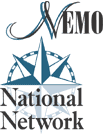 9/02
- New
National Network Logo!
9/02
- New
National Network Logo!
We are retiring our trusty Network logo for a new and improved look. The new logo (as well as other Network logos) is available to our Network members in the Member Resources section. Contact Kara at 860-345-4511 or email, kbonsack@canr.uconn.edu with all your logo questions and/or needs.
9/02 - NEMO Named the Group of the Month
The NEMO program was named the Group of the Month for July 2002 by a Canadian water quality organization. The Water Information Network (H2infO) is a project founded in late 1999 by RiverSides Stewardship Alliance, the Toronto Environmental Alliance and the Canadian Institute for Environmental Law and Policy.
The project aims to improve municipal water quality, quantity and flow by fostering and supporting community-based programs and increasing civic participation in national, provincial and local efforts to control municipal non-point sources of water pollution. H2infO promotes the achievement of sustainable municipal, provincial and national policies and programs respecting urban water quality by empowering civic and community action through research, information dissemination and exchange, partnership building and representation.
Anyone ready for a Mapleleaf NEMO program? Visit the H2infO website and see the write-up on NEMO! www.h2info.org.
9/02 - NEMO Featured in NWQEP
Can't get enough information about NEMO? NC State University's NCSU Water Quality Group Newsletter, NWQEP NOTES, is featuring NEMO in its latest issue! The article focuses on the impacts of the CT NEMO program. The May 2002 publication can be accessed on the NWQEP website. www.bae.ncsu.edu/programs/extension/wqg/issues/Notes_105.pdf



